Photo by Emily Roark
At Estes Design and Manufacturing, we recognize the importance of our people. Part of our philosophy is to hire people of high character. We strive to hire individuals who care about the work they do and about the customers we serve.
So, we want to highlight them and the incredible work they do. Estes would not be the company it is today without these amazing people and their effort and commitment to everything they do.

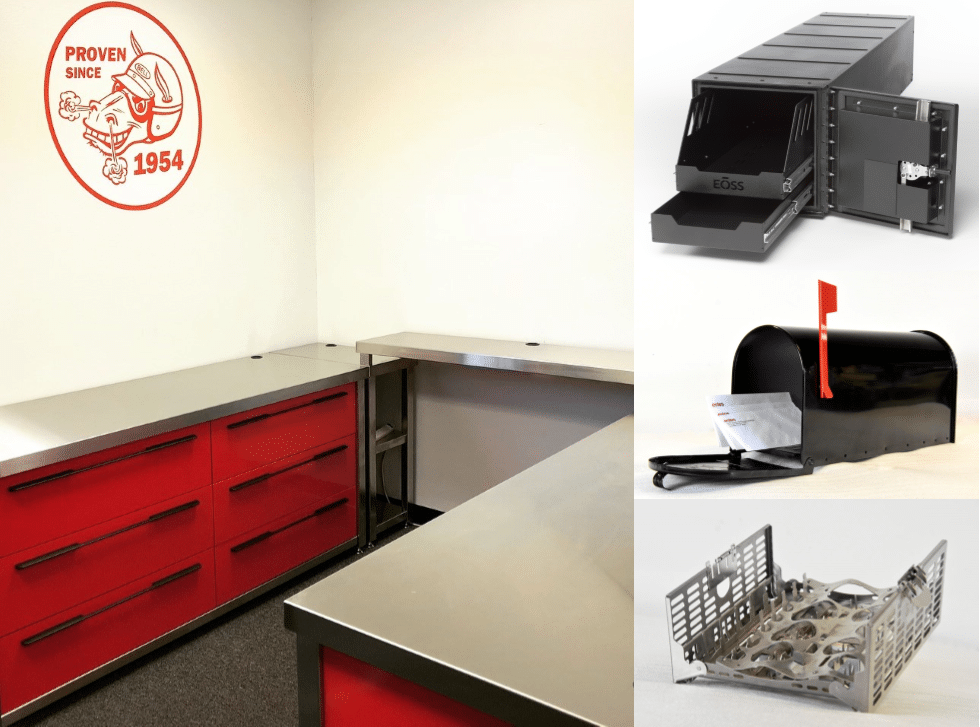
Photo by Emily Roark
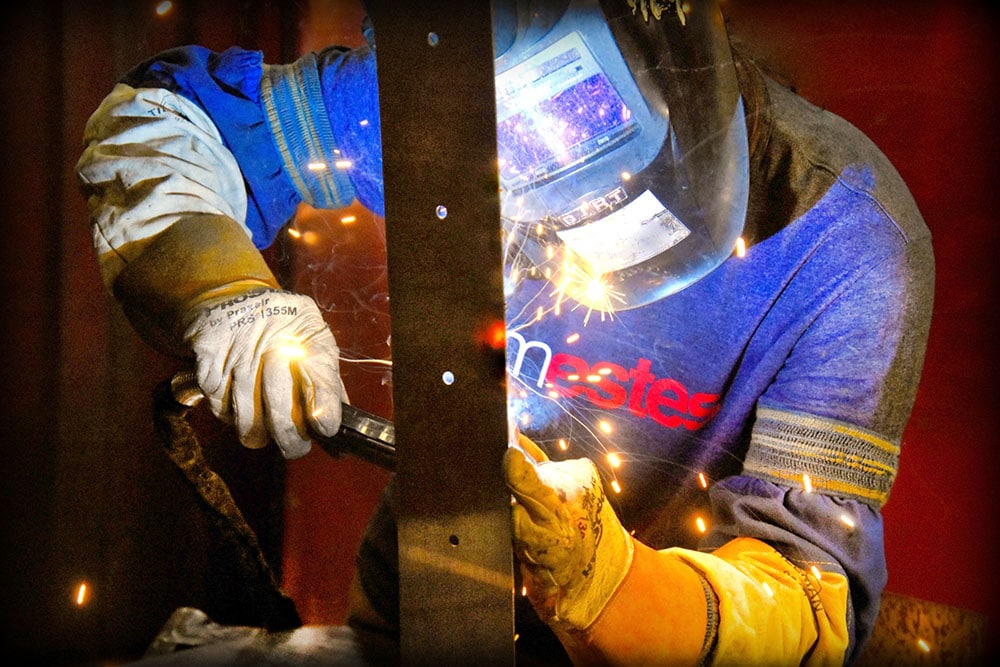
Photo by Emily Roark
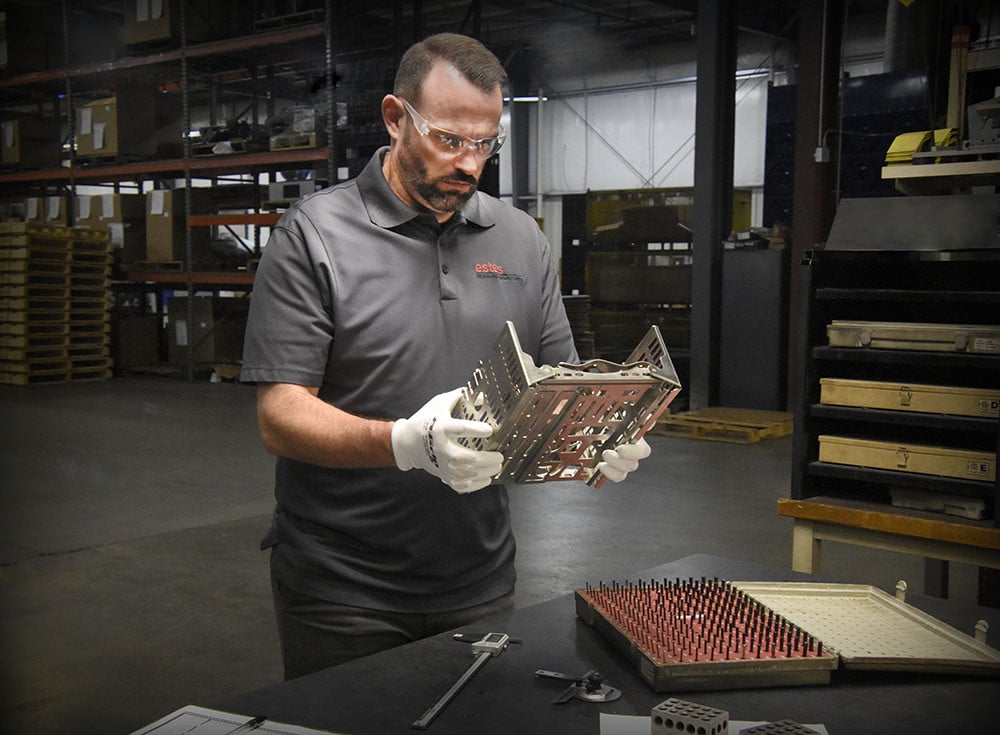
Photo by Emily Roark
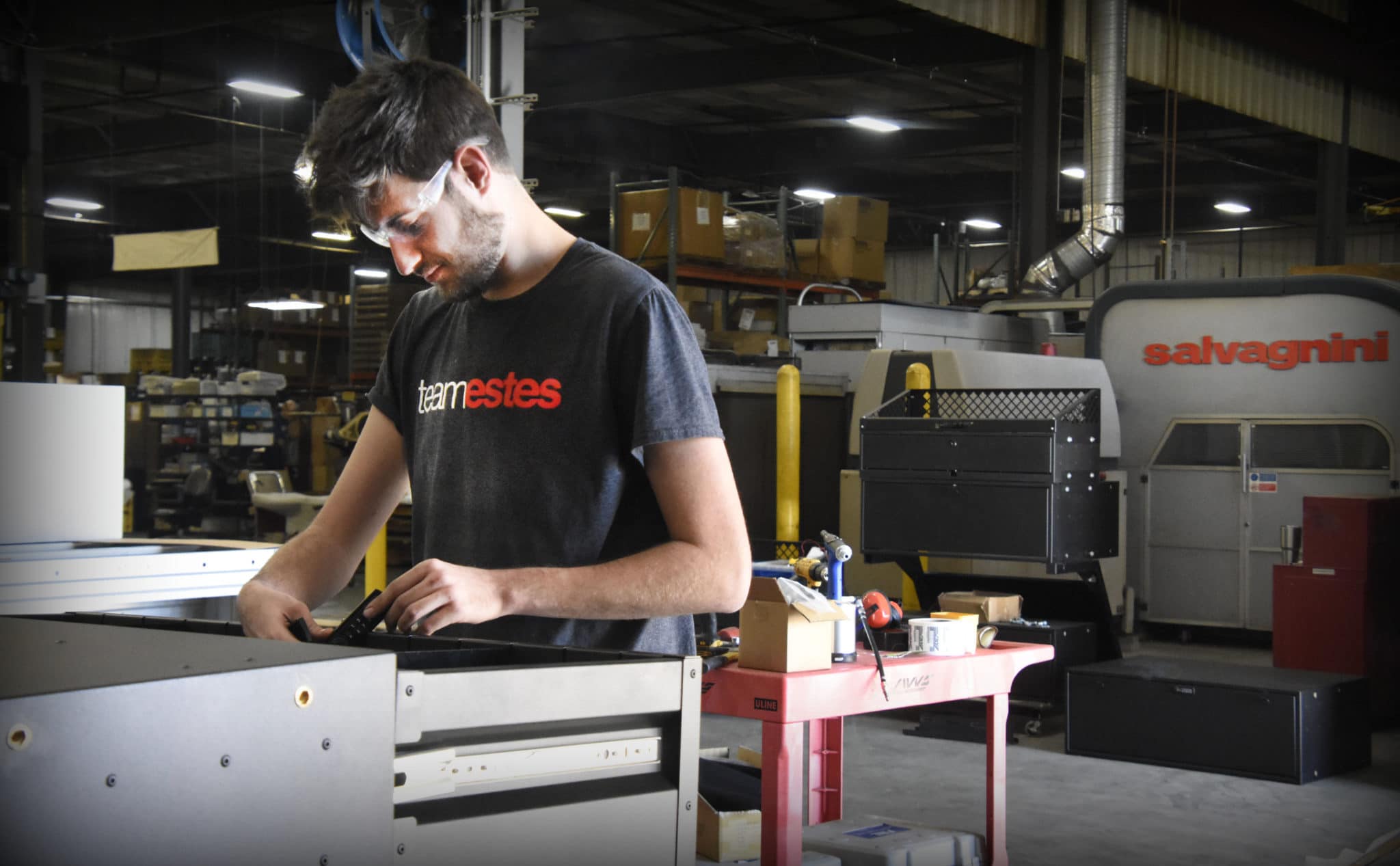
Photo by Emily Roark
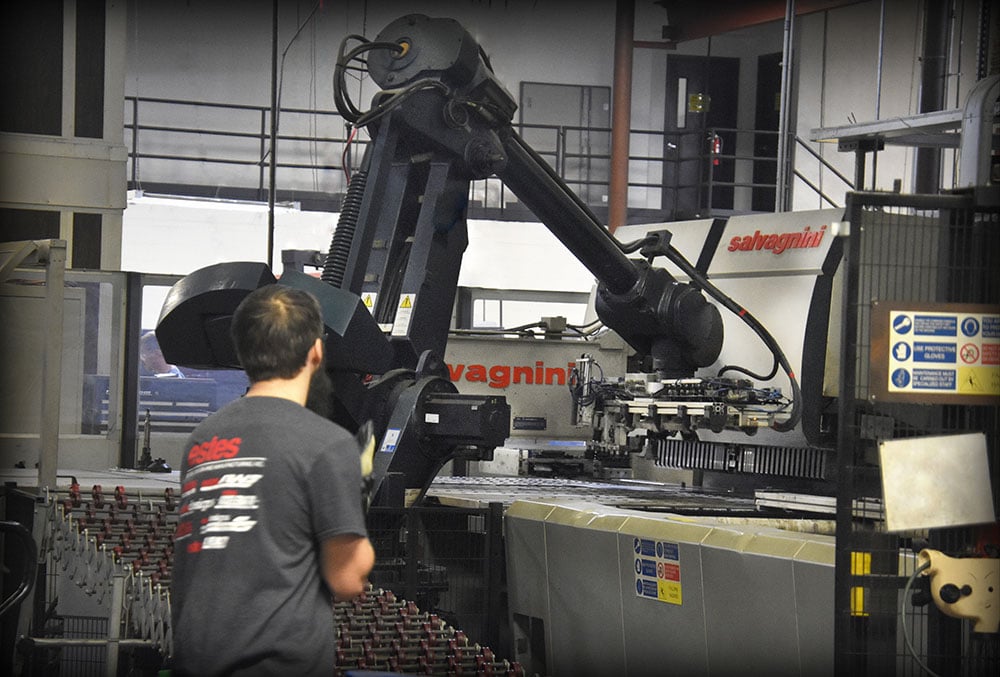
Photo by Emily Roark
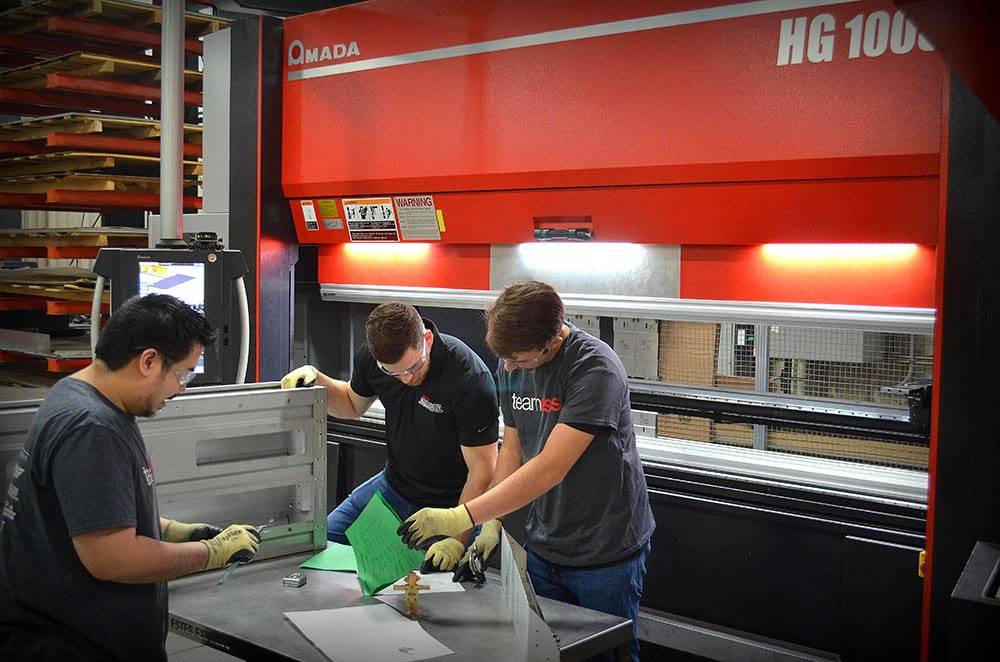
Photo by Emily Roark
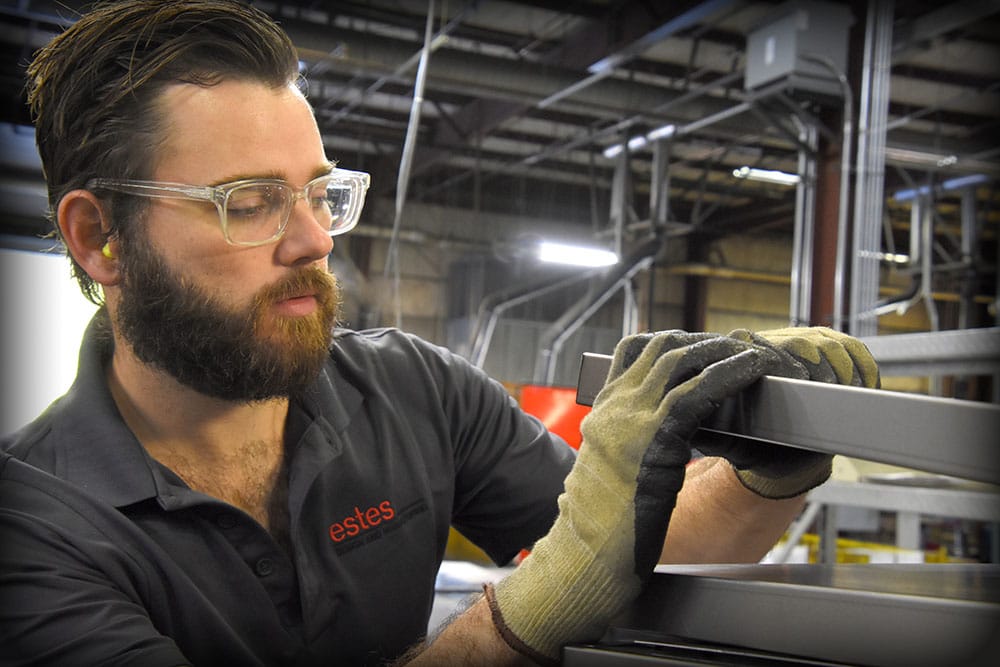
Photo by Emily Roark
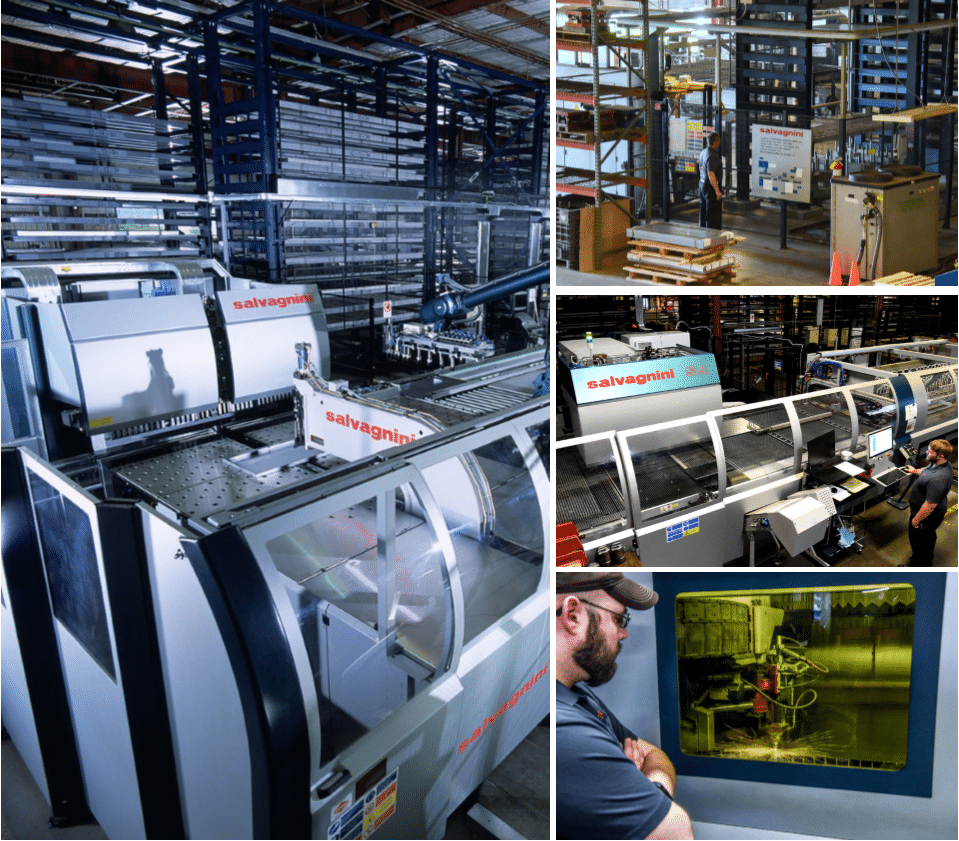
Photo by Emily Roark
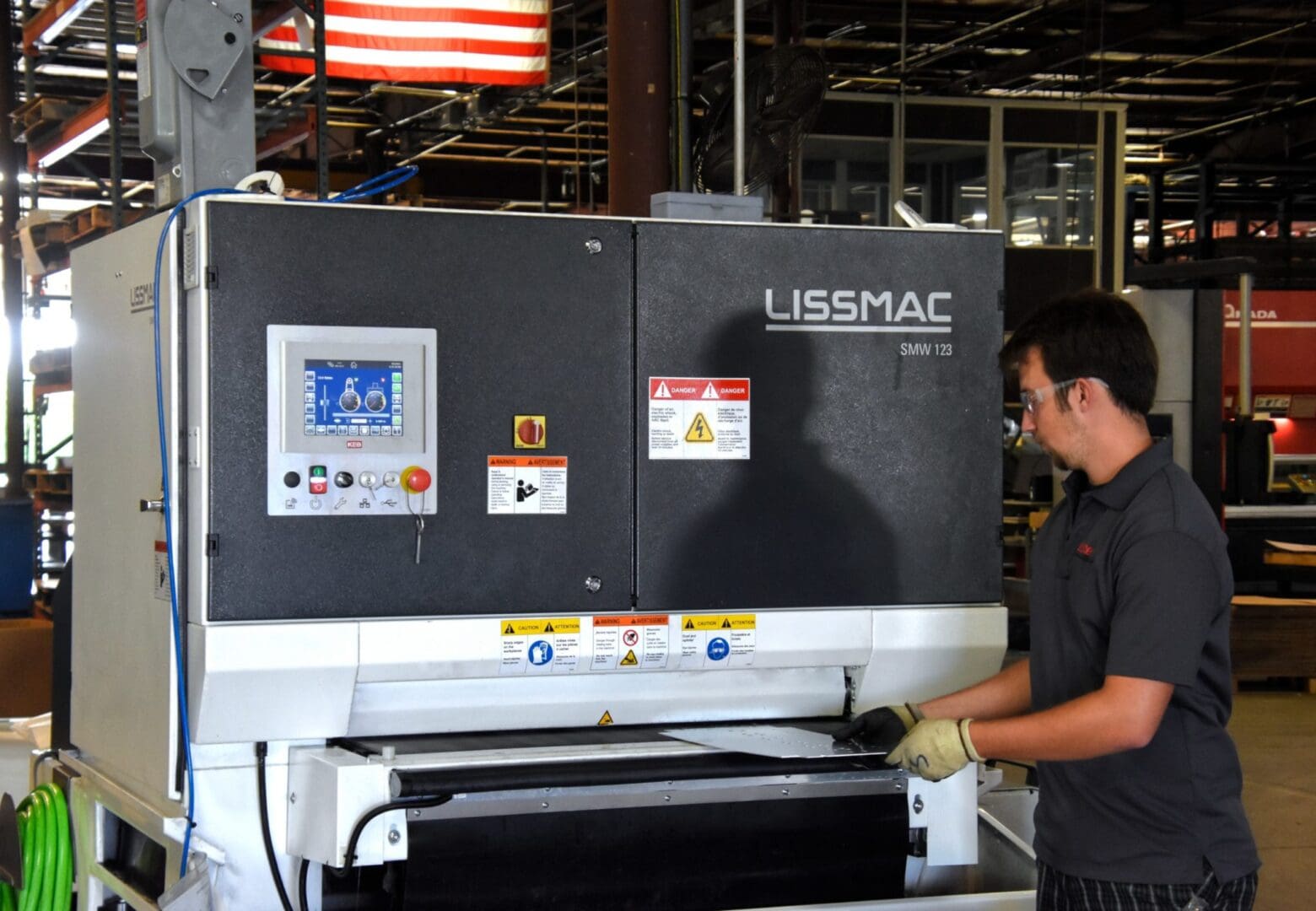
Spencer is working at our newest machine, the LISSMAC SMW 123 RB Wet Metal Finishing and Deburring Machine. This new machine provides high-end deburring and finishing for sheet metal parts, removing laser dross or burrs from punching processes. In addition to this, it can also add surface finishing grain to parts, if desired. It can run a variety of materials including steel, stainless steel, and aluminum, can process up part thicknesses ranging from 0.012″ to 4.7″, and features an automatic cleaning senor to ensure a high quality finish on every part. Estes believes that our investment in state-of-the-art technology aligns with our mission to create a competitive advantage for our customers through innovative design, cost savings, and speed.
Photo by Emily Roark
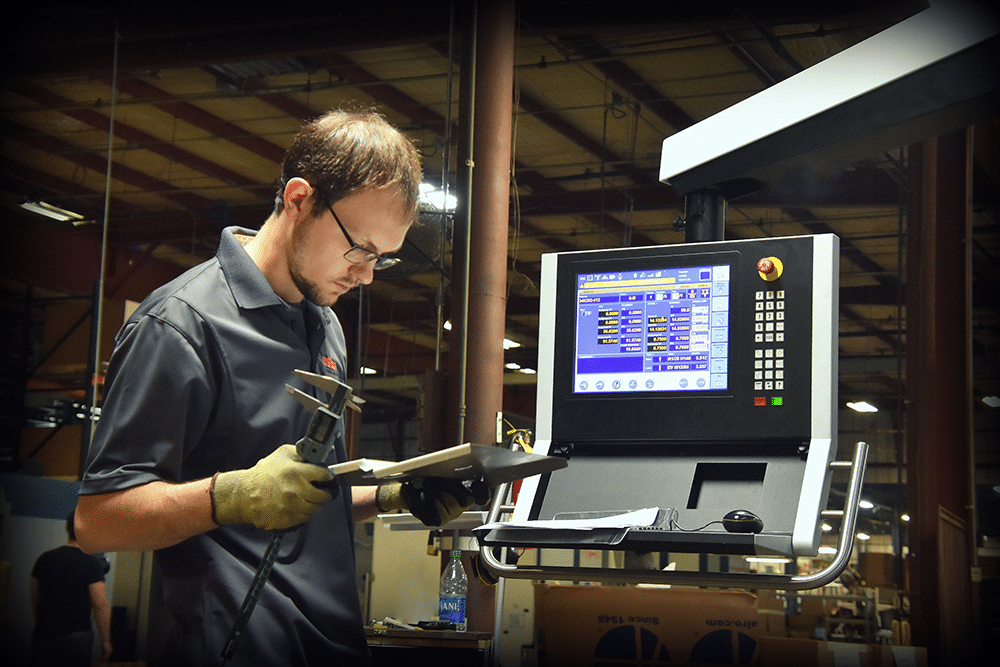
Estes is constantly looking for ways to improve in all facets of the business to uphold our company philosophy of Continuous Improvement. The company has set up measurement standards to track progress and improve customer value and satisfaction, quality, and speed to market. The result is an organization full of individuals constantly looking for a better way to do things, and these improvements incrementally enable us to reduce lead-times, improve quality, and meet delivery deadlines consistently for our customers, all at a competitive price.
Photo by Emily Roark
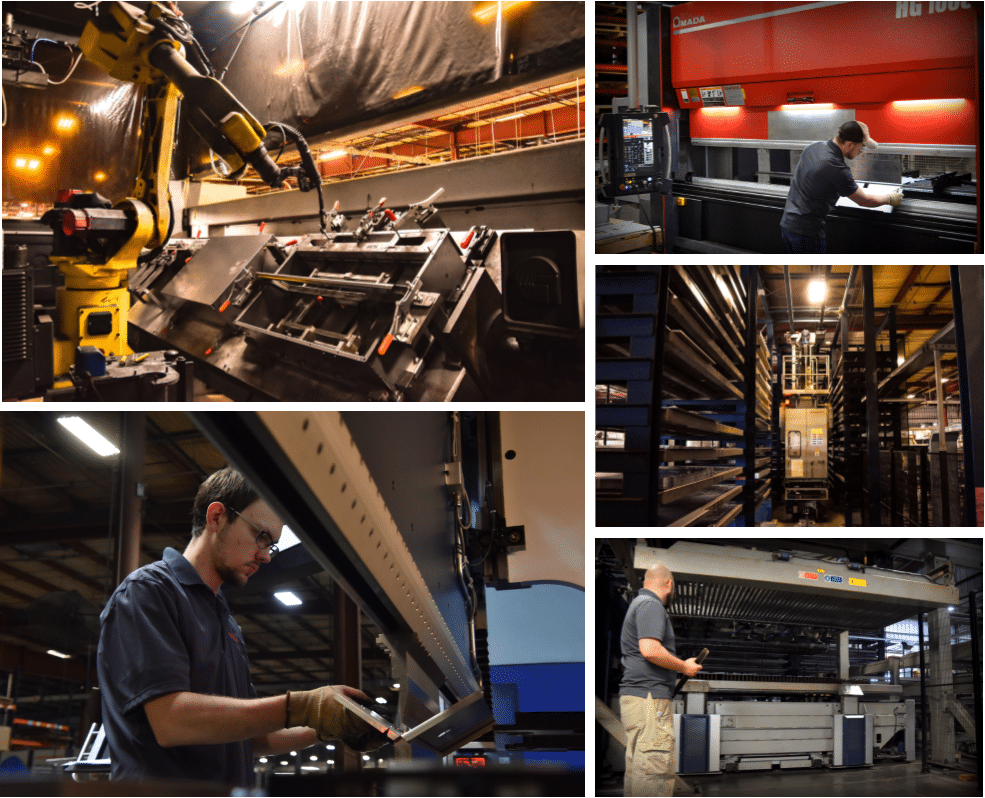
At Estes Design and Manufacturing, we’ve invested in the highest-quality technology available for our customers’ metal fabrication needs – machines whose unique capabilities benefit our customers through cost reduction, improved quality, and reduced lead-times. To uphold this pillar of our company philosophy, we seek to utilize machines that greatly improve quality and processing speeds while allowing us to fabricate extremely complex parts at a reduced cost, and we strive to proactively and constantly monitor our equipment and standards to better serve our customers.
Photo by Emily Roark
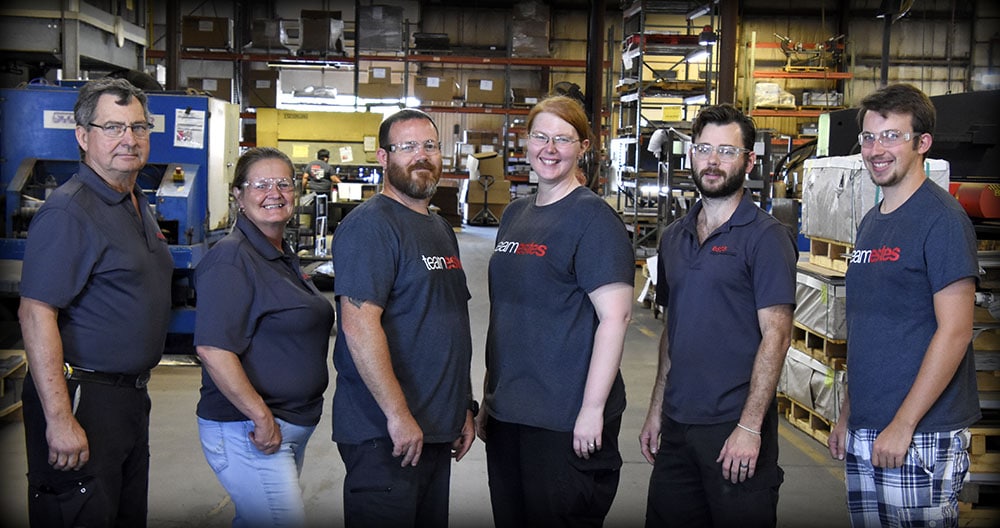
Another pillar in our company philosophy is that we employ People of High Character. At Estes Design and Manufacturing, we understand that the people we employee serve as the foundation for everything we do, and Estes strives to hire individuals who care about the work they do and about the customers the company serves. Estes employees treat customers’ projects as their own and seek to serve customers with dedication, honesty, and integrity at every stage of the project lifecycle. At the end of the day, we want the Estes name to be equally synonymous with honor and integrity as it is with premier metal fabrication.
Photo by Emily Roark
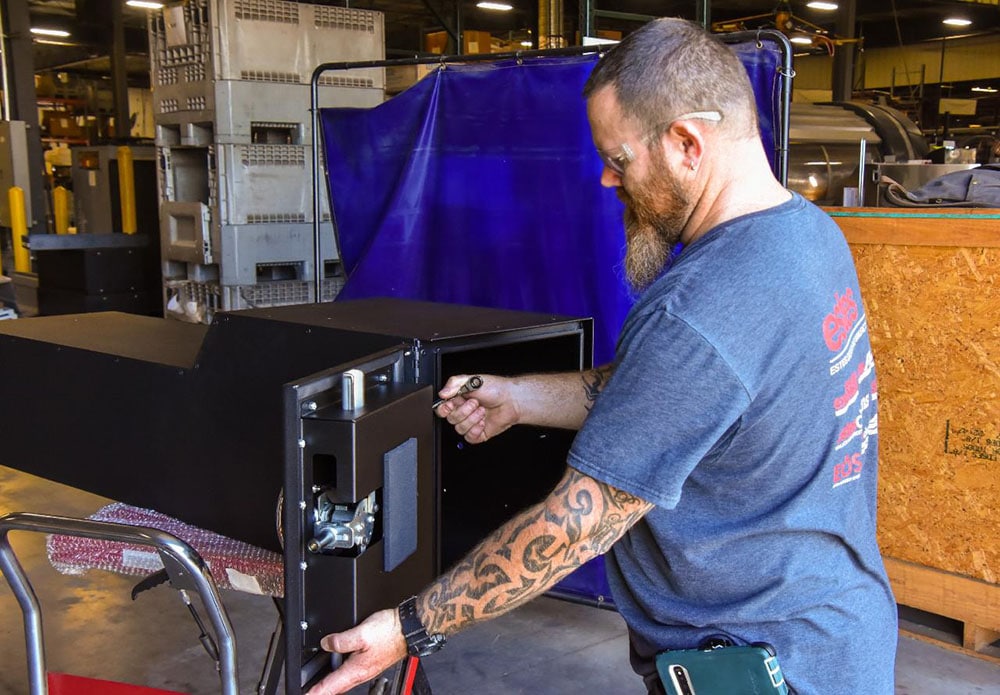
One of the four pillars of our company philosophy is Creative, Innovative Thinking, and Estes’ creativity is on display through our product development department. Assembly worker, Dave, is putting the finishing touches on an Estes Outdoor Sport Systems (EŌSS) Locker. With the help from our core group of engineers, we were able to develop the EŌSS Sportsman Locker, and this project has afforded us the experience of taking a product all the way from inception to market. Not only are we creating our own products, but we are also able to assist customers in developing products for a variety of industries. We work with each customer from design to prototyping to manufacturing to ensure they are getting exactly what they want with reduced lead-times and lower prices.
Photo by Emily Roark
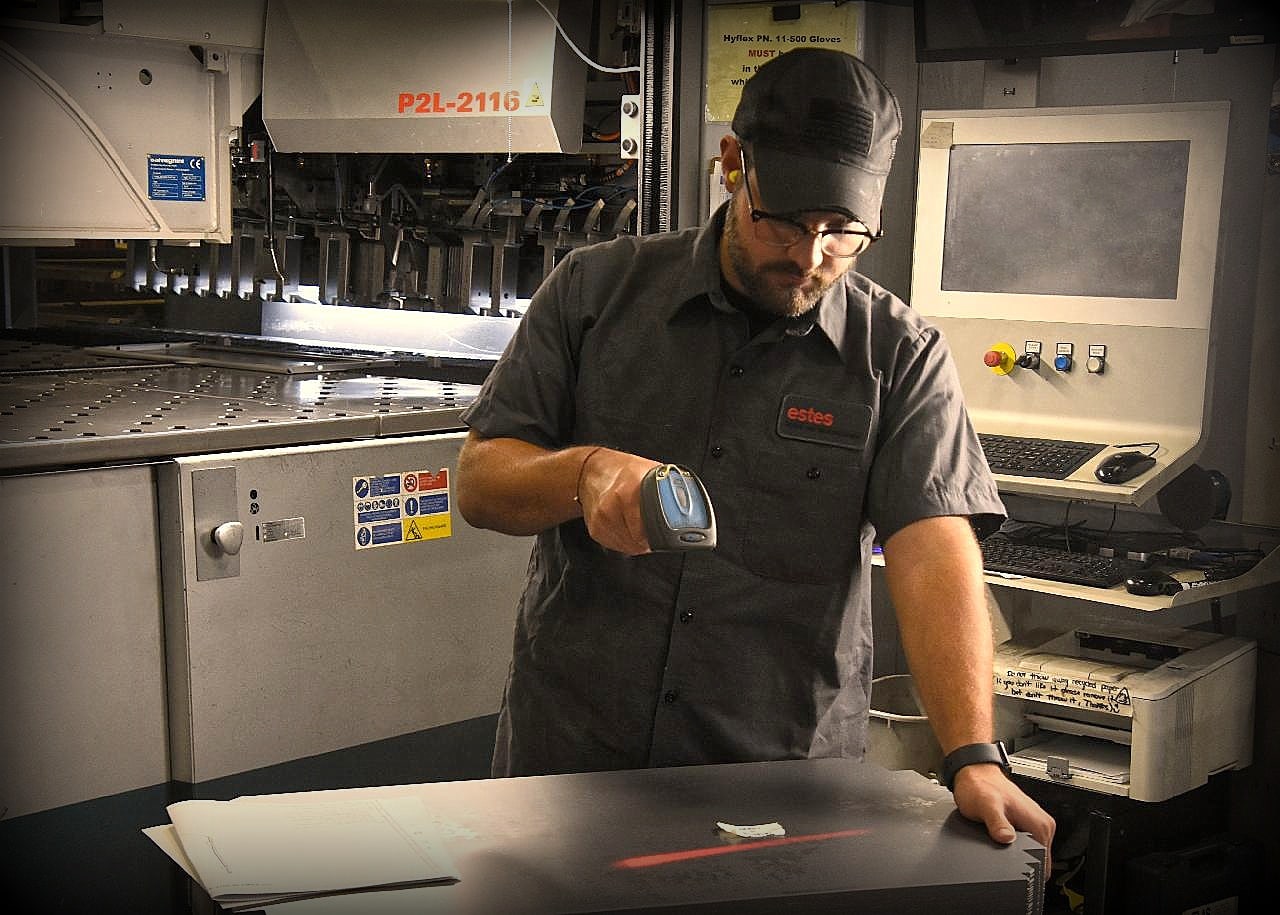
At Estes Design and Manufacturing, we’ve invested in the highest-quality technology available for our customers’ metal fabrication needs – machines whose unique capabilities benefit our customers through cost reduction, improved quality, and reduced lead-times. With State-of-the-Art Technology being one pillar of our company philosophy, this is something that we are constantly working towards. One example of this is our Salvagnini P2lean forming machine. With the simple scan of a bar code, the machine control loads the part program and configures the tooling – all in a matter of a few seconds. Tooling adjusts automatically from part to part and bend to bend, eliminating any setup time and adding efficiency to our customers’ products.
Photo by Emily Roark
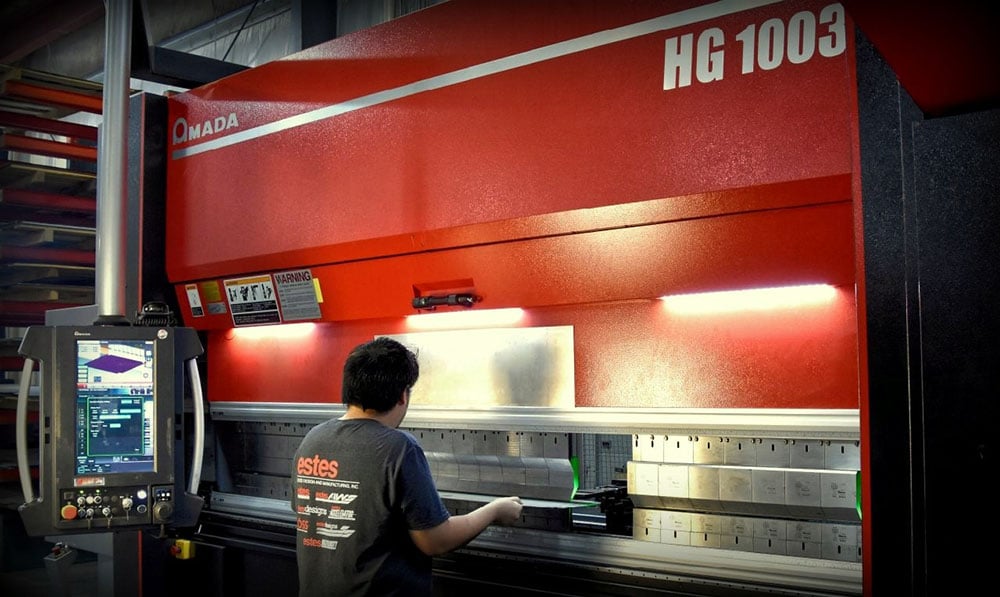
Prototype worker, Mikhail, is at our new Amada HG 1003 ATC press brake in our Estes Accelerator department forming a new prototype design. This machine’s differentiating feature is its patented Automatic Tool Changer. Punches and dies are automatically loaded and unloaded with tool manipulators, eliminating the need for manual setup. The result is an expected reduction in setup time translating into lower costs and increased throughput with shorter lead-times. The dedicated equipment in our Estes Accelerator cell eliminates the need to try and cram a prototype into a production schedule and logjams can be avoided. The combination of dedicated personnel and equipment allows us to reduce lead-times and increase customers’ speed to market.
Photo by Emily Roark
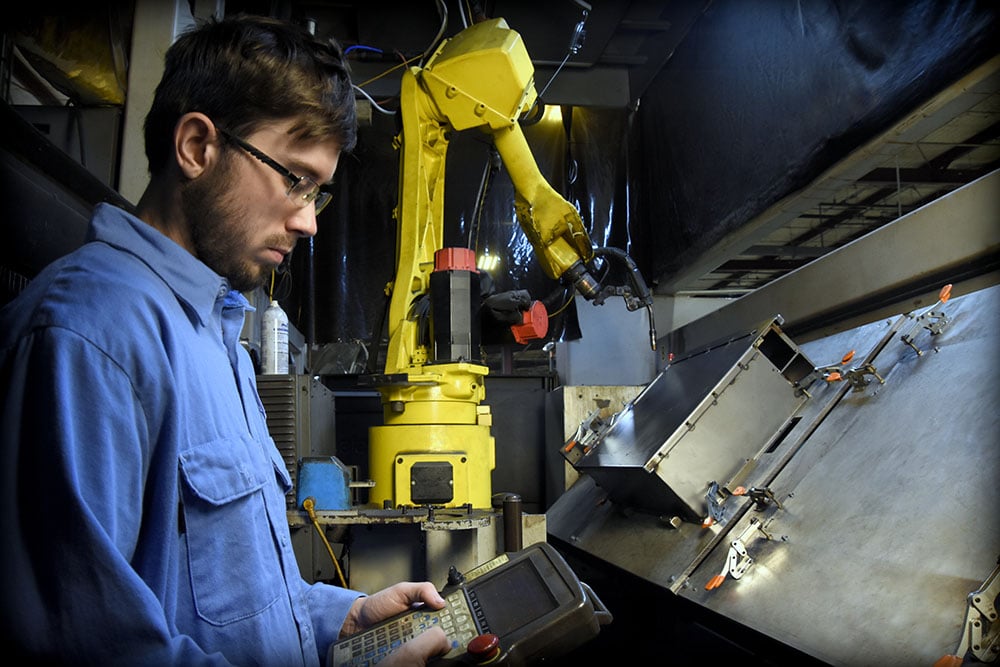
Welder, Trevor, is at our Genesis 4M Robotic Welder programming the robot arm to weld battery boxes. This machine utilizes automation with its Ferris wheel positioner, which allows the robot to weld the metal on one side of the table while the operator loads and unloads assemblies from the other side. This essentially doubles throughput, and with higher welding speeds, you are able to receive high-quality parts at a reduced cost. A wide variety of sheet metal parts can be run through this unique machine, and the Genesis Robot is the perfect solution to any welding project.
Photo by Emily Roark
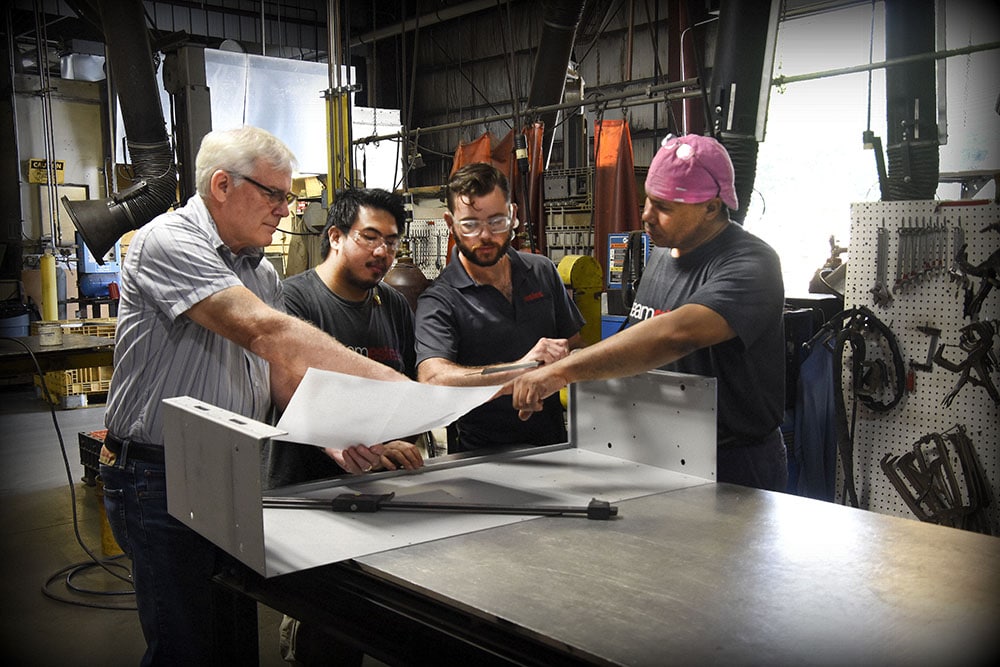
Our production and engineering staff are reviewing a customer’s part design looking for ways to reduce manufacturing costs. The three main ways Estes offers cost reduction is through automated technology, lean initiatives and design for manufacturing and assembly (DFMA). Our team evaluates the customer’s part using value engineering to reduce manufacturing costs and simplify assembly. High levels of automation maximize uptime and improve part accuracy and consistency while lowering costs. DFMA adds value to the product by increasing speed to market, improving production efficiency, and lowering the cost per part. Through these cost reduction processes, we are able to fabricate parts at a lower cost that are easier to assemble.
Photo by Emily Roark
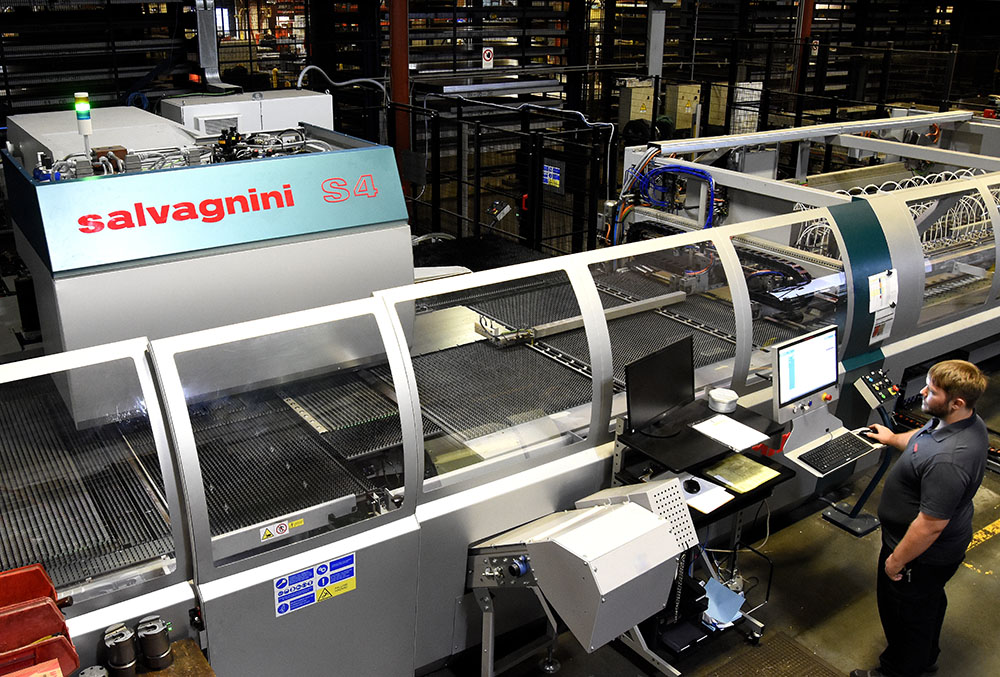
S4 operator, Jeremiah, is at our Salvagnini S4 CNC Shearing/Punching Center. This machine combines the punching versatility of a turret press with the blanking capabilities of a shear. The S4 punches features into the blank and then shears the perimeter of the blank to separate it from the sheet. The punched parts are then automatically unloaded onto a tray to be temporarily stored in our Salvagnini MV Warehouse until they are ready for forming operations. Precision and speed are ensured through digital communication and the center’s advanced control techniques. The S4 is capable of running unmanned, allowing it to run lights-out over weekends when tight deadlines are necessary. With this machine, Estes is able to deliver high-quality parts, reduce lead-times, and ensure on-time delivery.
Photo by Emily Roark
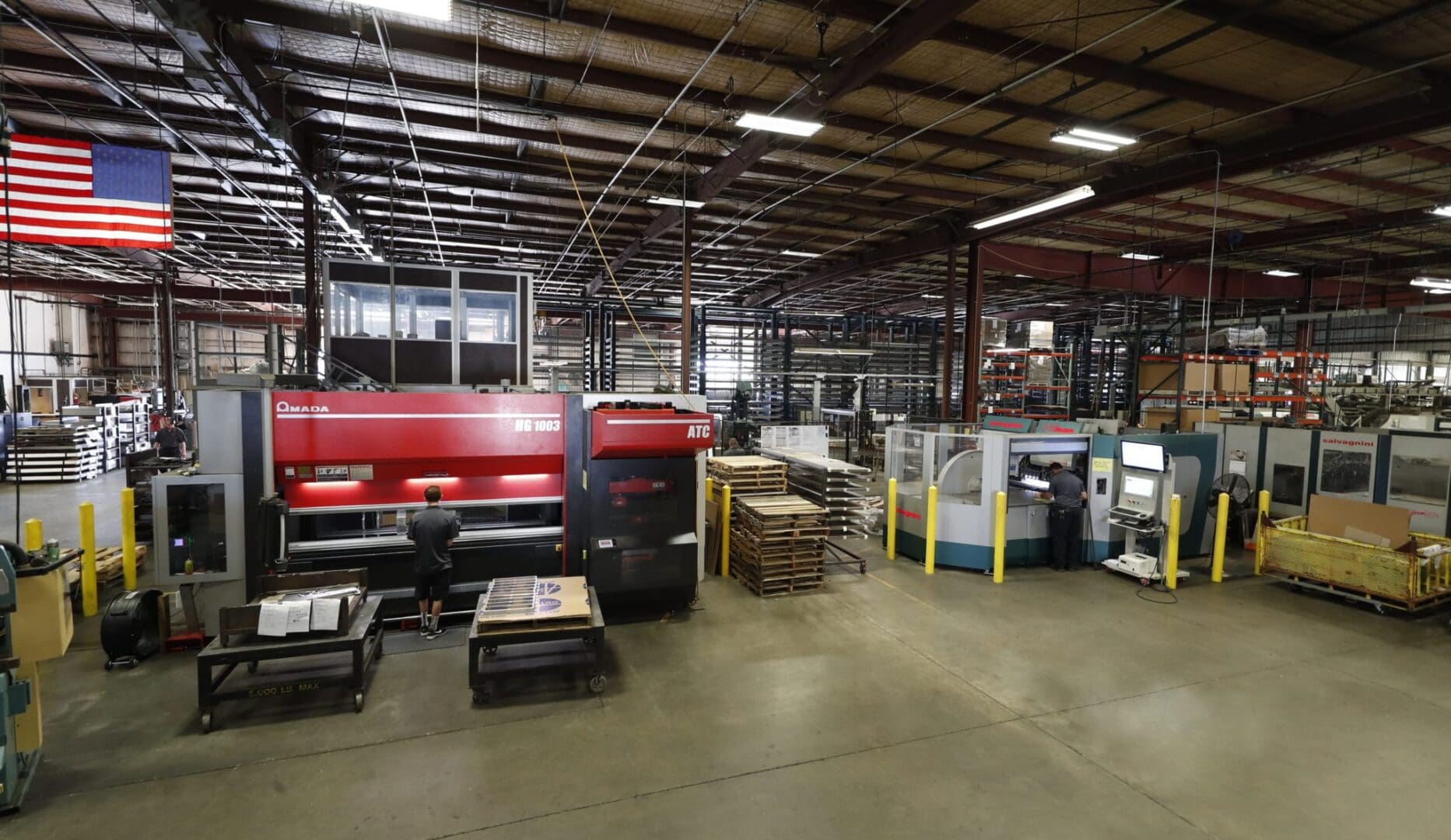
By using lean manufacturing at Estes, we strive to offer our customers reduced lead-times, greater quality, consistent on-time delivery, and reduced costs. At the heart of lean manufacturing is continuous improvement which is one of the four pillars of our company philosophy. Our team focuses on waste versus value-added activities in the manufacturing process, which means our employees are identifying and removing wasteful practices from their production and constantly seeking improvement. The use of measurement standards helps to track progress, and we believe one of the best ways to improve is to constantly re-evaluate and grow as an employee–which makes for a stronger company.
Photo by Emily Roark
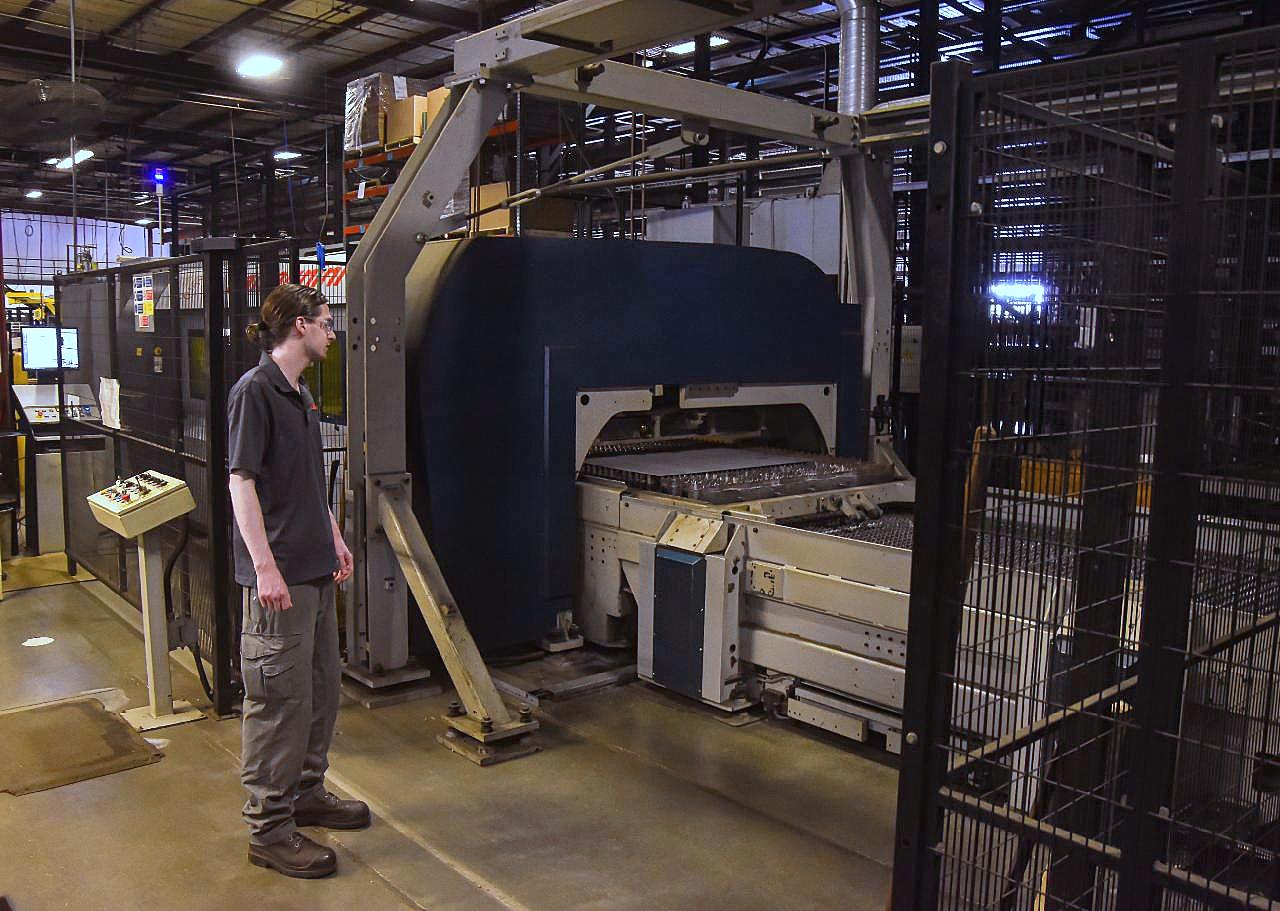
Production worker, Luke, is overseeing the L5 as it automatically loads raw material and unloads sheet skeletons using the Automatic Sheet Loading (ASL) system. The ASL consists of two identical cutting tables that swap places once cutting is completed on a sheet, making the L5 extremely efficient. While the new sheet is cutting, the ASL removes the cut parts and sheet skeleton with a retracting finger system that fits between the cutting grids of the table. It then lifts the parts/skeleton off the cutting table and stores them on a tray that goes back into our MV Warehouse. The ASL will then load a new sheet on the cutting table in preparation for the next table swap. The ASL adds to a fully automated and integrated production environment that greatly reduces lead-times while still producing our customers’ parts with a high level of precision.
Photo by Emily Roark
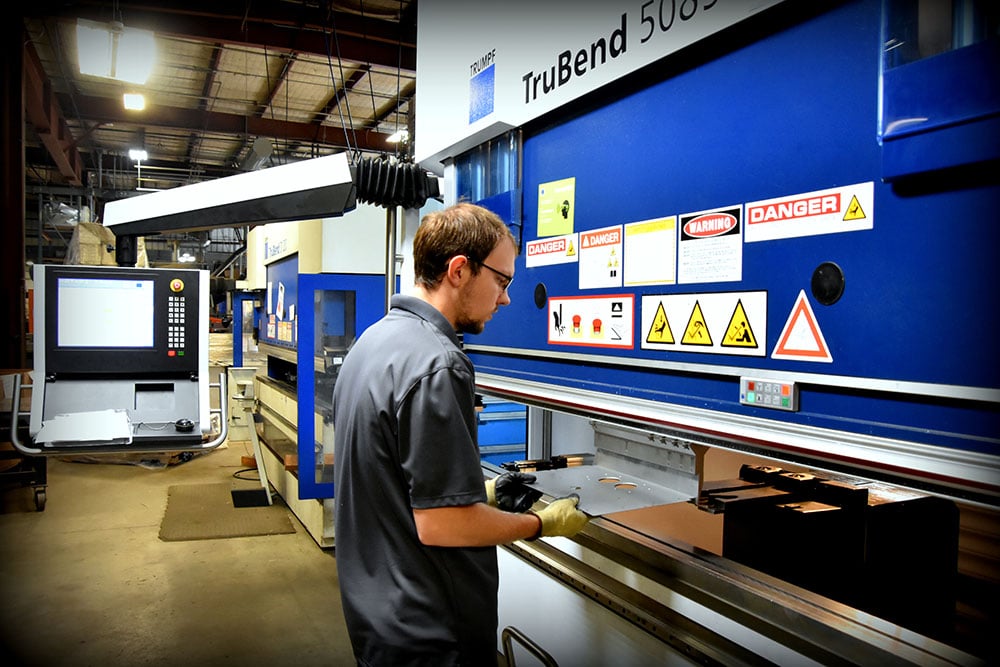
Press brake operator, Karric, is at our Trumpf Trubend 5085 X press brake. This machine features thickness-controlled bending sensors that automatically adjust the plunging depth based on the thickness of the part being formed. This allows for high accuracy and complex bends in both thin and thick sheet metal parts. The Trumpf also allows for off-line programming to increase processing speeds and ensures precise angles across long bends with automatic crowning features. Setup times are greatly reduced with the machine’s lightweight click-in tools, cutting down on lead-times and costs. This Trumpf is an ideal solution for all of our customers’ bending applications – no matter how simple or complex the part may be.
Photo by Emily Roark
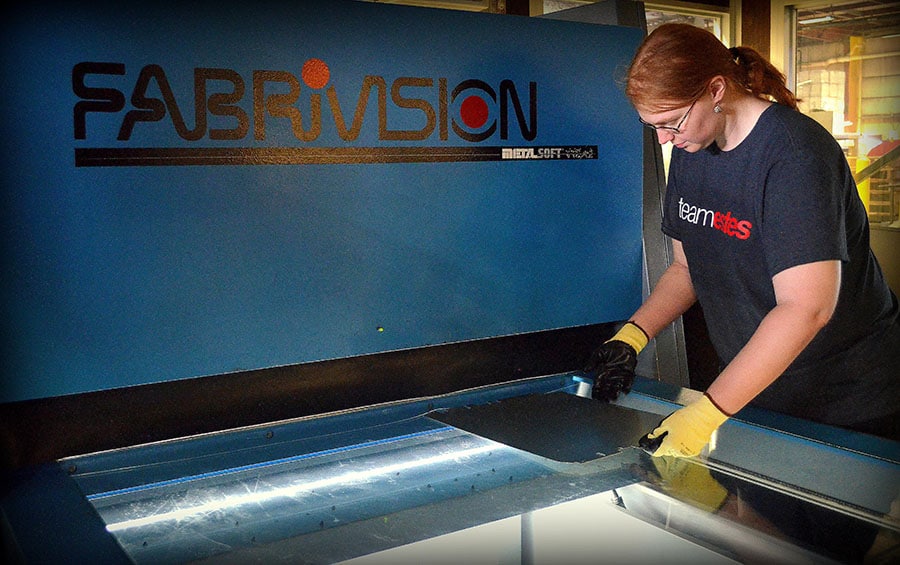
Production worker, Emily, is at our Fabrivision scanner ensuring that this part blank is within tolerance and that the blanking operation has been correctly executed. Our Fabrivision scanner utilizes cameras to capture the cut perimeter and feature edges of a blank as the scanning bridge passes over the part. These scanned perimeter and feature outlines are then compared back to the CAD-generated flat DXF of the part blank, generating a detailed color map, and then indicating the conformance of the part edge versus the engineered blank. This quality step ensures the quality and accuracy of punched and laser cut parts before they are moved on to forming operations.
Photo by Emily Roark
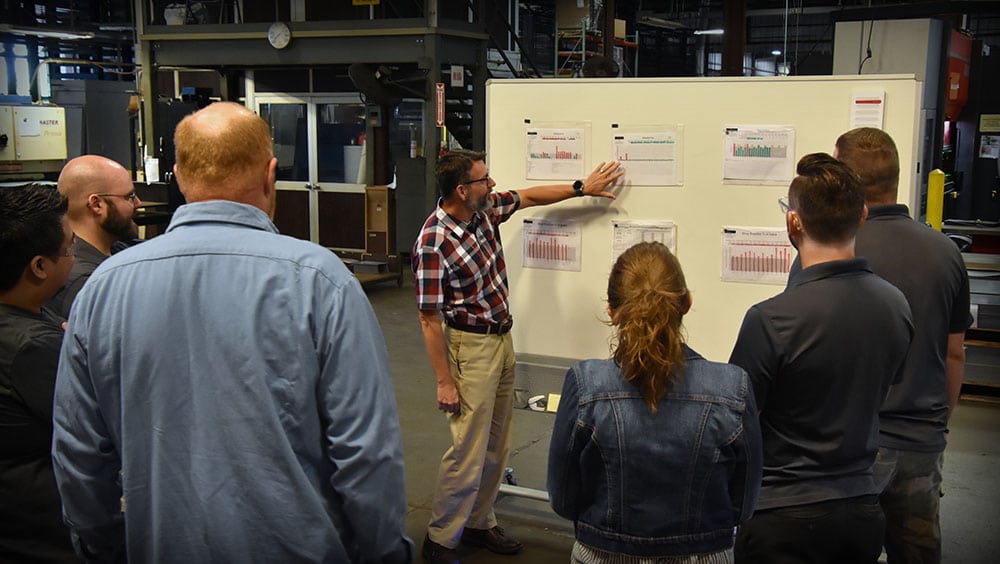
Continuous improvement serves as one of the four pillars of our company philosophy, and Estes is constantly looking for ways to improve all facets of the business. To ensure this continuous improvement mindset goes beyond a philosophy statement, we have set up measurement standards in the form of daily layered accountability (DLA) to track progress and highlight areas of improvement. DLA is a systematic way of daily monitoring the status of departments or projects based on various metrics. Through our continuous improvement efforts, we are able to offer our customers shorter lead times and lower prices without compromising on quality.
Photo by Emily Roark
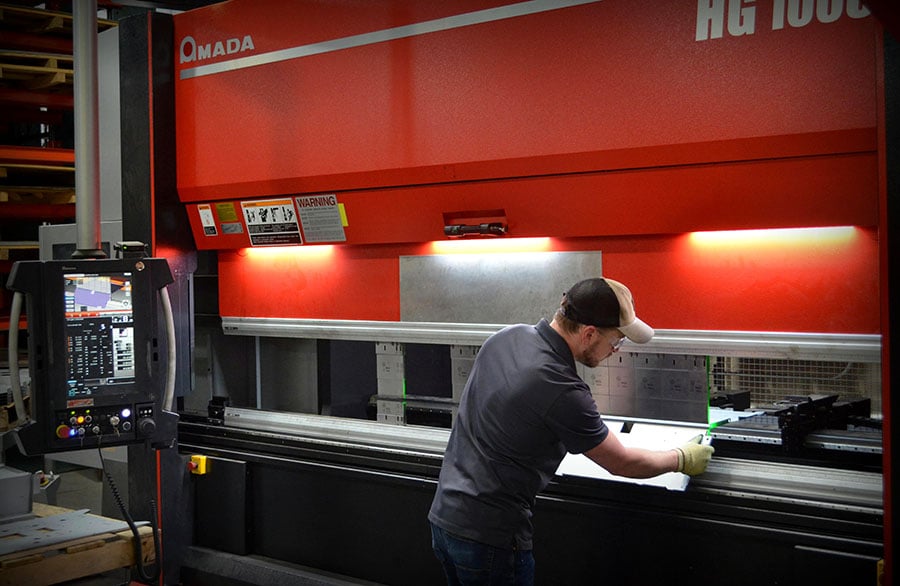
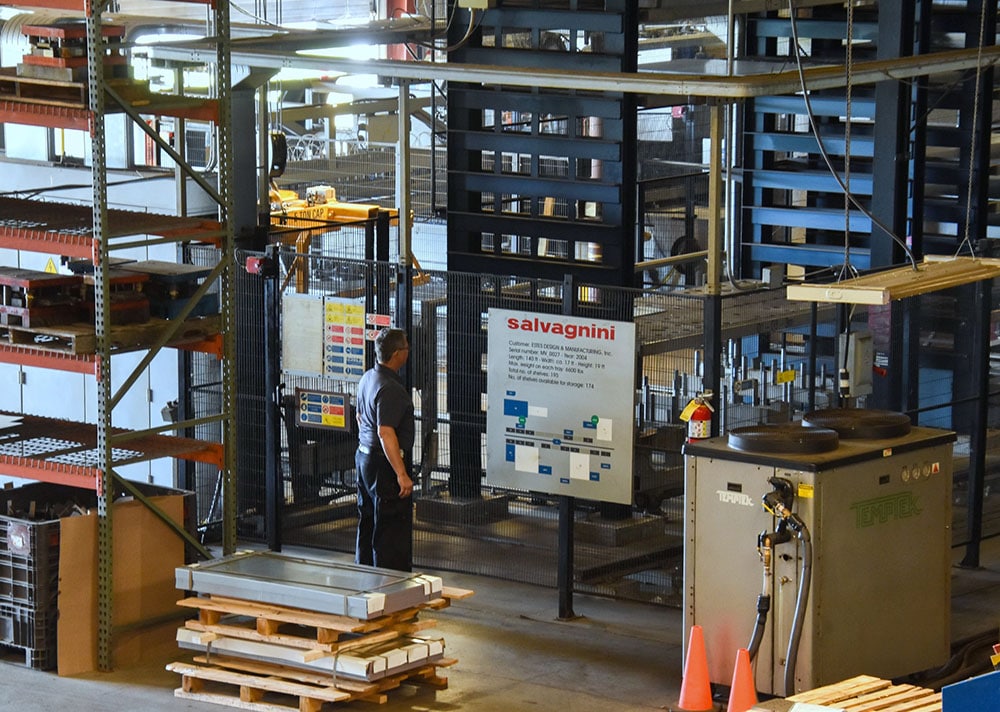
Mike is at our Salvagnini MV Warehouse loading raw material onto one of its 195 trays designed to store raw material and work-in-process. Used to reduce wasted motion and time, the Salvagnini MV Warehouse serves as the backbone to our fully automated Estes Max Velocity cell. Using a picker crane with a telescopic fork system that runs on a rail, the MV automatically moves raw materials and part blanks to the various pieces of fabrication equipment attached to it as needed. The cell’s software schedules and sequences the material through the punching, shearing, laser cutting, and bending operations, creating a fully automated and integrated production environment that reduces transfer times while increasing machine efficiency to reduce lead-times on our customers’ projects.
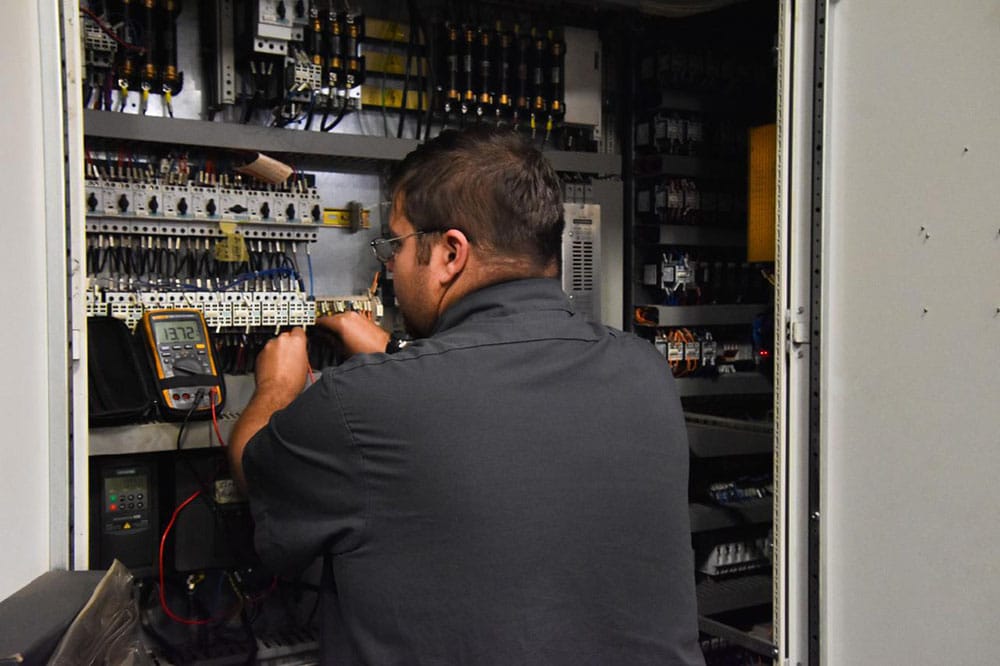
Robotics technician, Wesley, is in the process of testing the automation control system on our Salvagnini L5 fiber laser with a voltage analysis. Wesley is responsible for routinely evaluating the efficiency and reliability of our industrial robotic systems and then calibrating them to achieve maximum quantity and quality. At Estes Design and Manufacturing, we’ve invested in the highest-quality technology available for our customers’ metal fabrication needs – machines whose unique capabilities benefit our customers through cost reduction, improved quality, and reduced lead-times. We strive to proactively and constantly monitor our equipment and standards to better serve our customers.
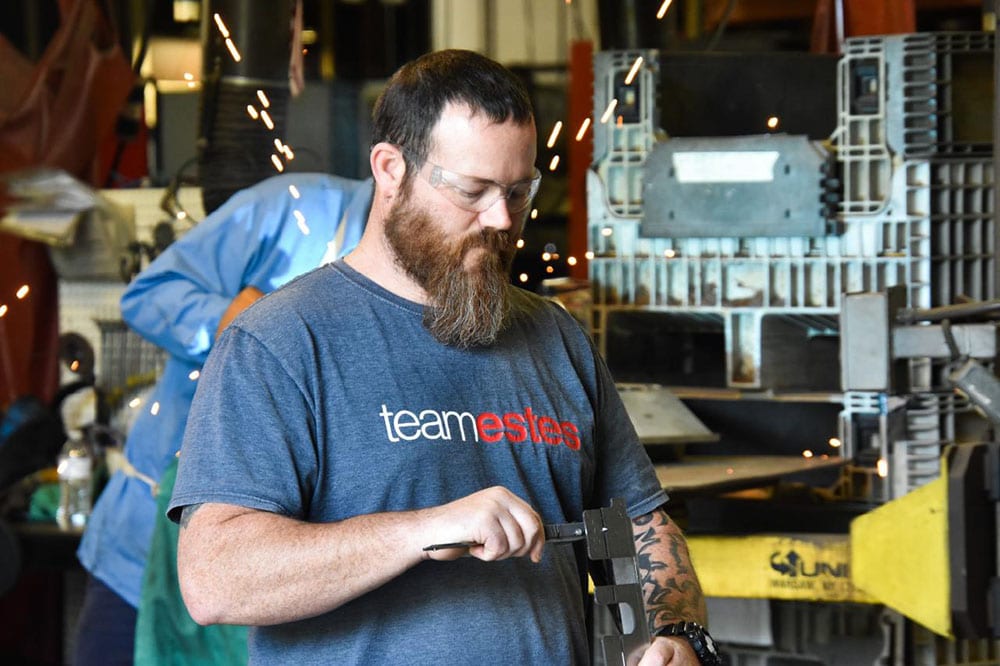
Estes Design and Manufacturing is a sheet metal shop committed to quality, and production worker, David, is performing in-process inspection on these control panels. Our inspection process begins with our experienced setup personnel. With each process setup the part is first verified by the setup operator against the prescribed inspection instruction. Once the setup operator has a part believed to be within specification, the setup part is taken to the inspection area where a dedicated shift inspector checks the part for setup approval. In-process inspections are sampled through the run, and final inspection and a visual audit takes place once all operations are complete. Estes is committed to an effective quality management system and backed by our engineering staff and state-of-the-art manufacturing facility, stands ready to assist in your manufacturing projects.
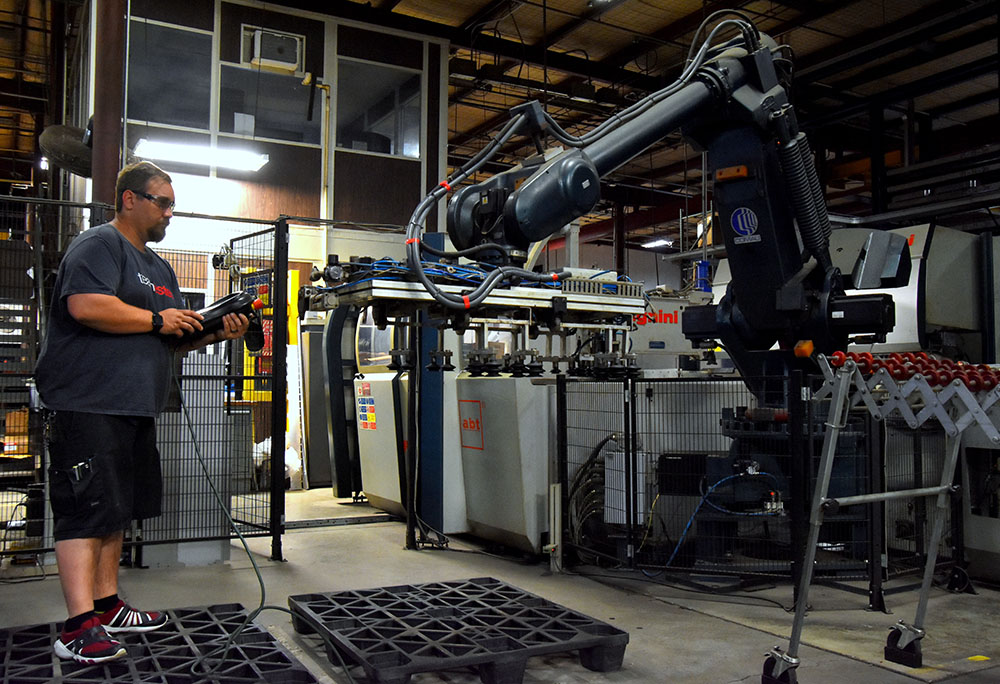
Production lead, Levi, is at our Salvagnini P4 panel bender calibrating the automated robot arm to run ventilator cover panels. The P4 panel bender is a fully automated machine with advanced capabilities, allowing it to form extremely complex parts in a single setup. Unlike traditional press brakes that require different tools for different bend configurations, tooling in this panel bender adjusts automatically from bend to bend and part to part. Accuracy is unparalleled because of the panel bender’s integrated advanced sensors that measure the blank, including material thickness, for precise placement and bending. The sensors also detect any deformations caused by variations in temperature. The collected data is used to instantly calculate the correct force required to bend the sheet metal. Once completed, the part is automatically unloaded from the machine via the automatic robot arm.
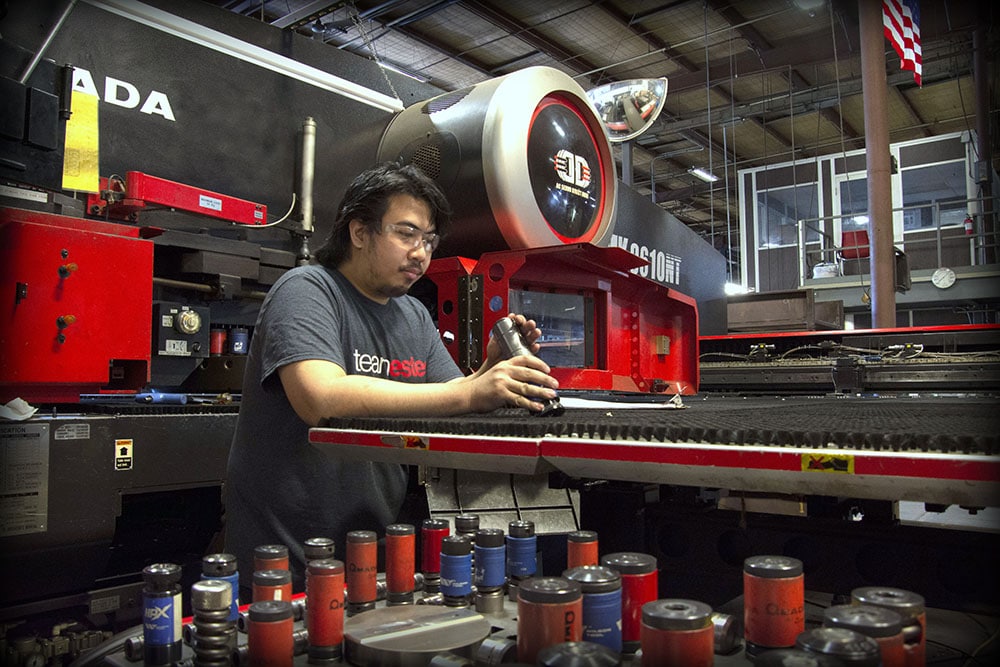
The turrets serve as the work horses on our production floor, and turret operator, Mikhail, is at our AMADA AMERICA, INC. EMK3610NT turret punch press setting up tooling. The turret has the ability to punch a large array of material types and thicknesses and can sometimes serve as a better choice than a laser depending on part design. There is a vast selection of special tooling options available at the turret that can emboss, stamp part numbers, run ribs in panels, punch out and form louvers, and much more. This machine allows us to accommodate unique part features on our customers’ projects.
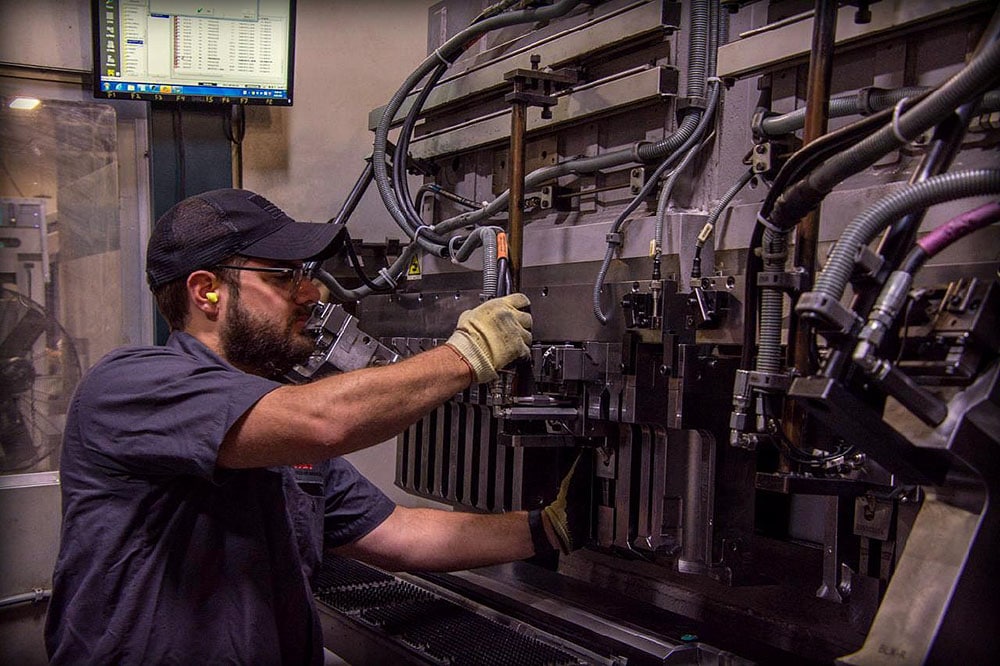
Panel bender operator, Fabio, is at one of our numerous CNC panel benders setting up tooling to run drawers for cabinetry units. Our Salvagnini panel benders utilize state-of-the-art features that minimize setup times and allow for efficient hands-off forming capabilities. In addition to this, our panel benders have unparalleled accuracy and repeatability numbers and are capable of forming a wide variety of part types and complex bend sequences. These capabilities all culminate into machines that reduce costs while increasing speed on our customers’ sheet metal fabrication projects.
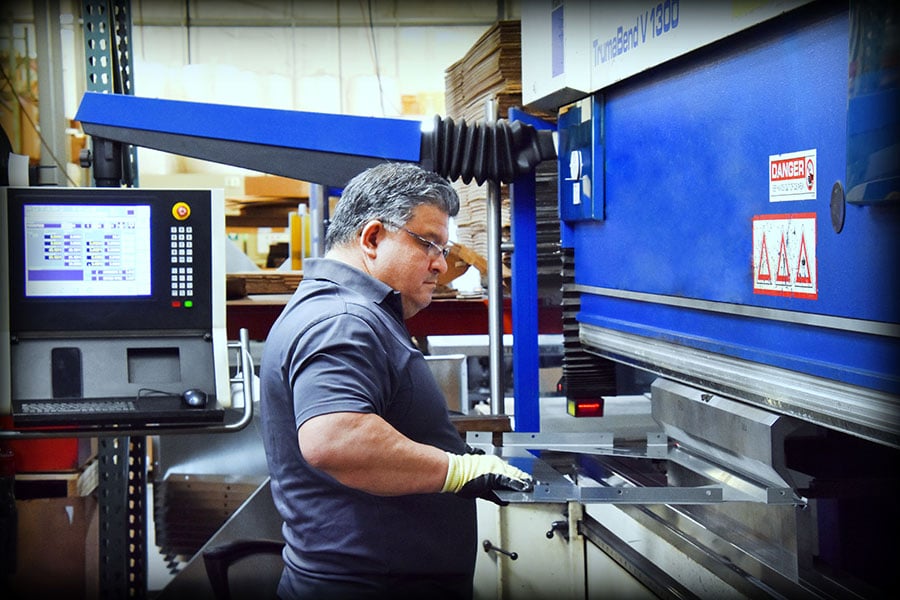
Press brake operator, Morris, is at our Trumpf TrumaBend V 1300 press brake forming brace panels. This machine is one of the most versatile press brakes in our shop. It’s easy to use and its comprehensive touch screen controller makes programming complex parts a much simpler task. Setup times are greatly reduced with the machine’s hydraulic activated clamps which make tool loading much quicker, cutting down on lead-times and costs. The advanced back gauge system can handle a wide variety of part types and bend sequences and our extensive tooling options cover a wide array of material thicknesses. The Trumpf’s ability to hem and flatten parts, with its forward/backward shifting bed, sets it apart from other conventional presses. This press brake delivers high accuracy and quality, ensuring precise angles for our customers’ sheet metal projects.
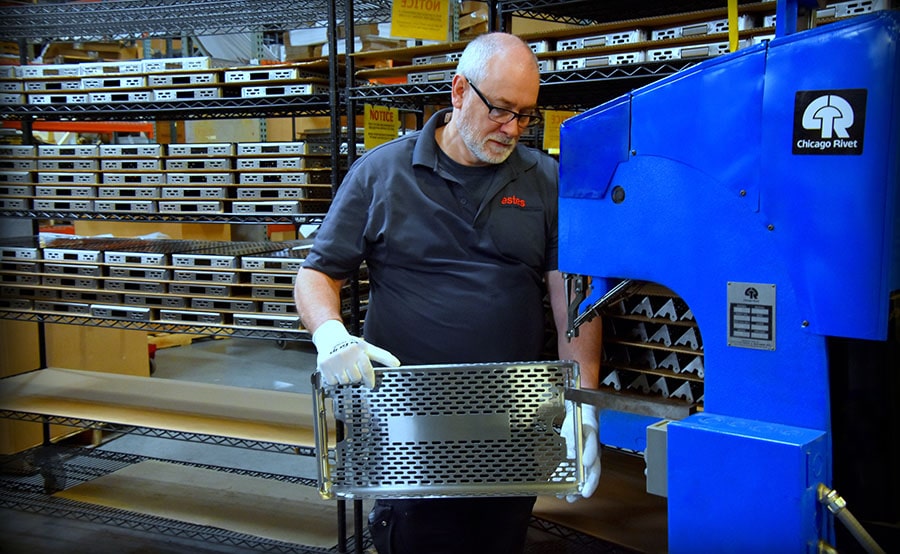
Medical assembler, Wayne, is working on riveting these medical tray components. From sterilization cases and trays to ventilators to medical components and weldments, Estes brings medical design innovation and fabricating automation to the medical industry. Estes has worked with top medical manufacturers to develop high quality fabricated medical products that cost-effectively combine form with function. With each medical product we design, our goal is to use as few components as possible, which helps reduce costs and assembly time for our customers’ products.
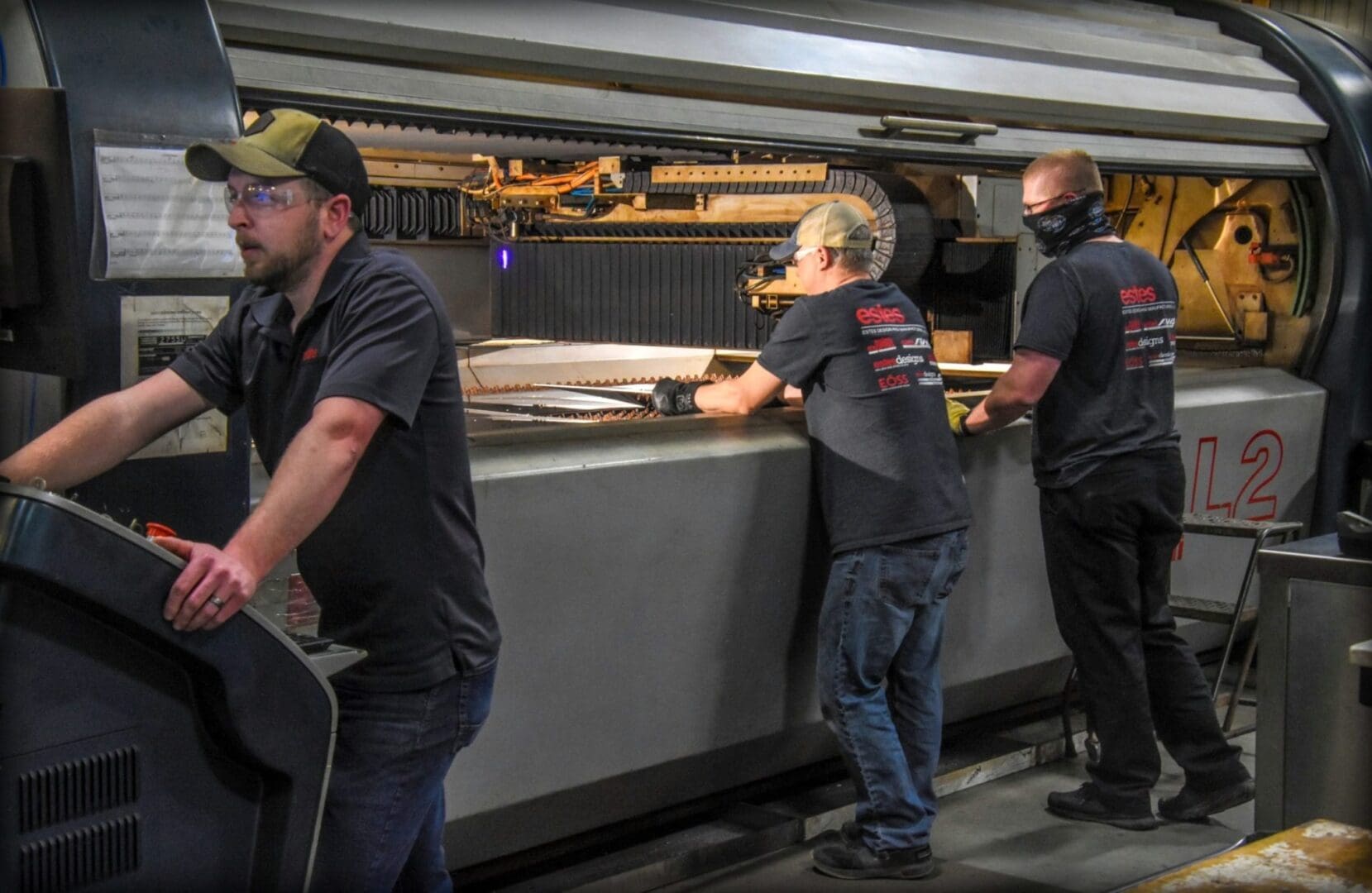
Estes Accelerator team members Brandon, Casey, and Brad are at our Salvagnini L2 working on laser cutting part blanks for a customer’s new prototype. The dedicated equipment in our Accelerator cell eliminates the need to find a hole in a production schedule and avoids logjams. In addition to this, Brandon, Casey, and Brad all serve as dedicated project managers who specialize in prototypes and product development work and handle the entire prototype project from quoting through programming through production. No hand-offs means tight lead-times are met and on-the-fly revision changes aren’t lost in the shuffle. The combination of dedicated personnel and equipment allows us to reduce lead-times and increase customers’ speed to market.
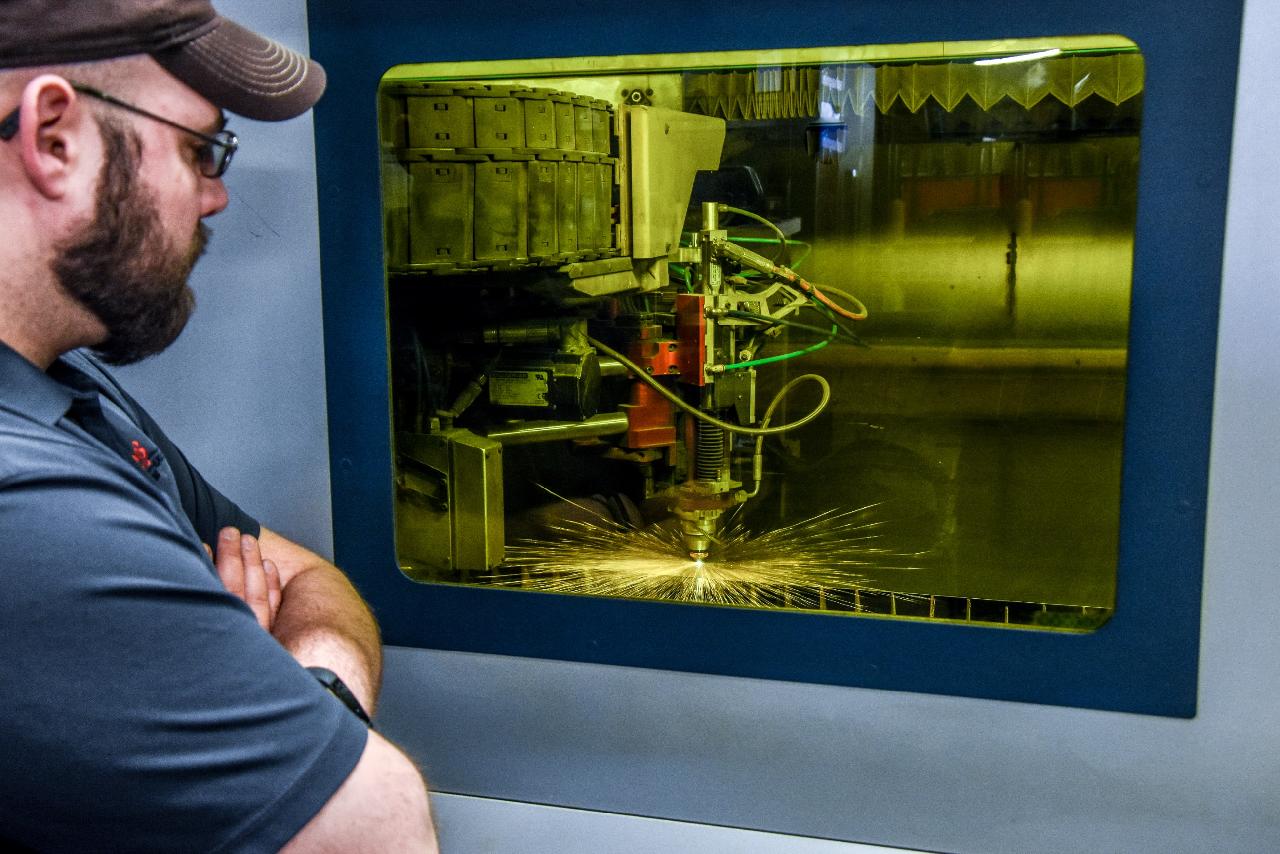
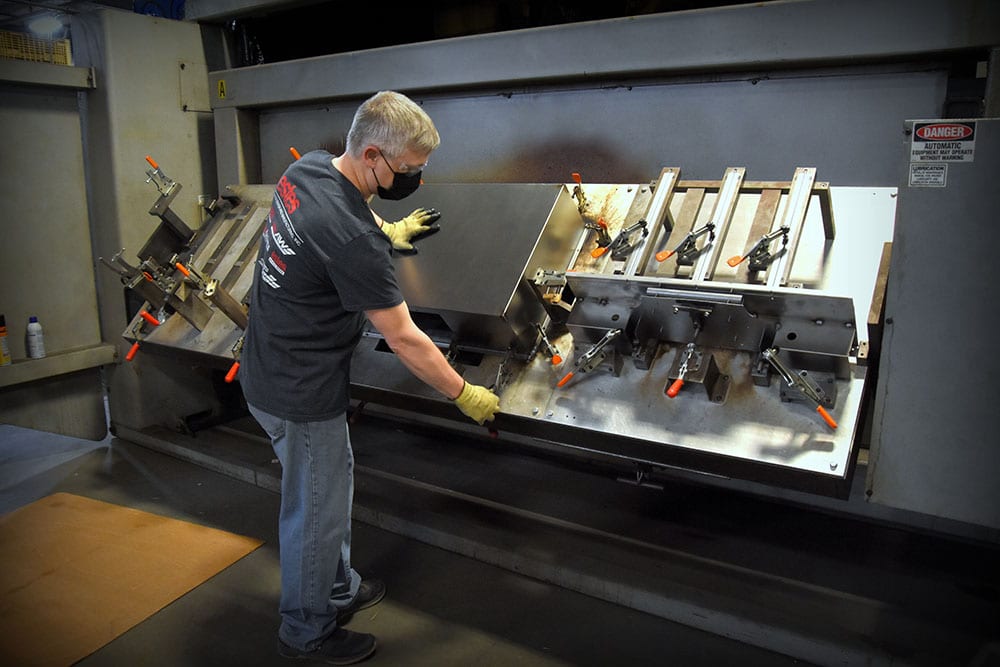
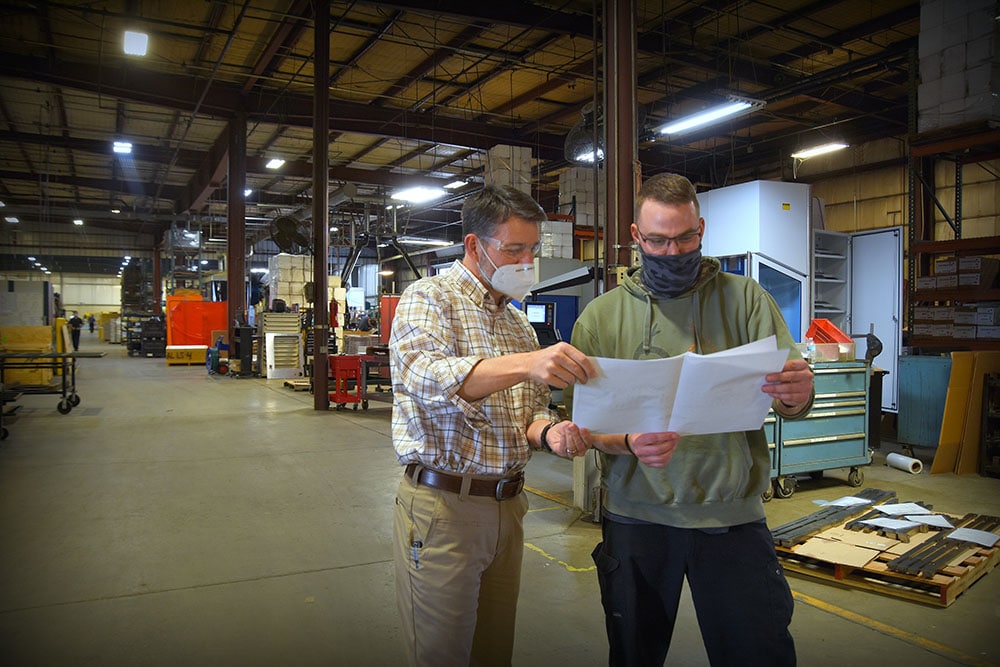
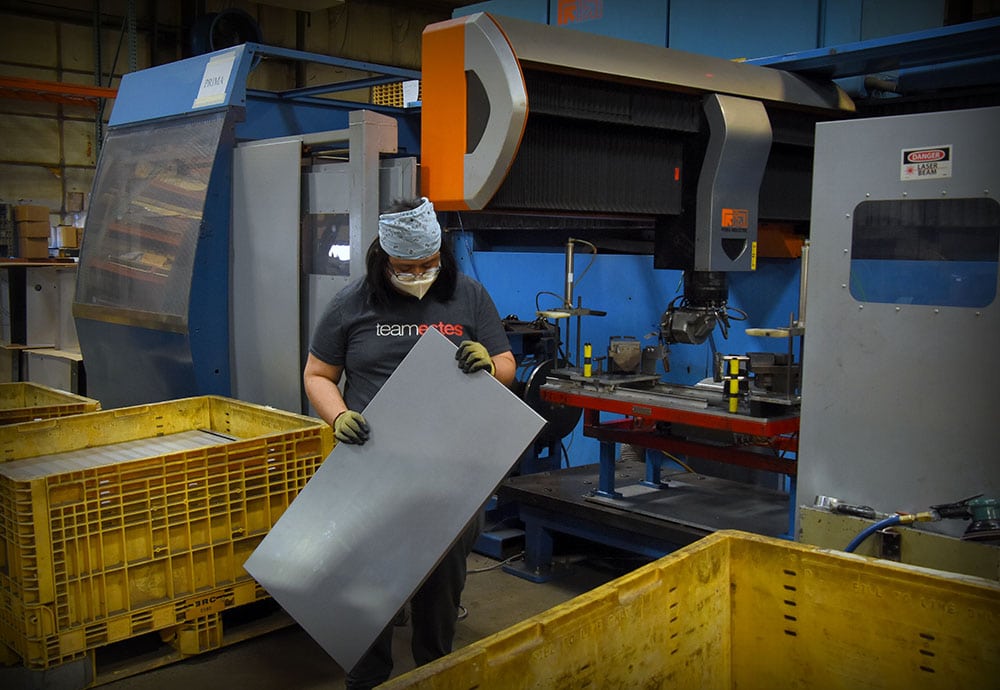
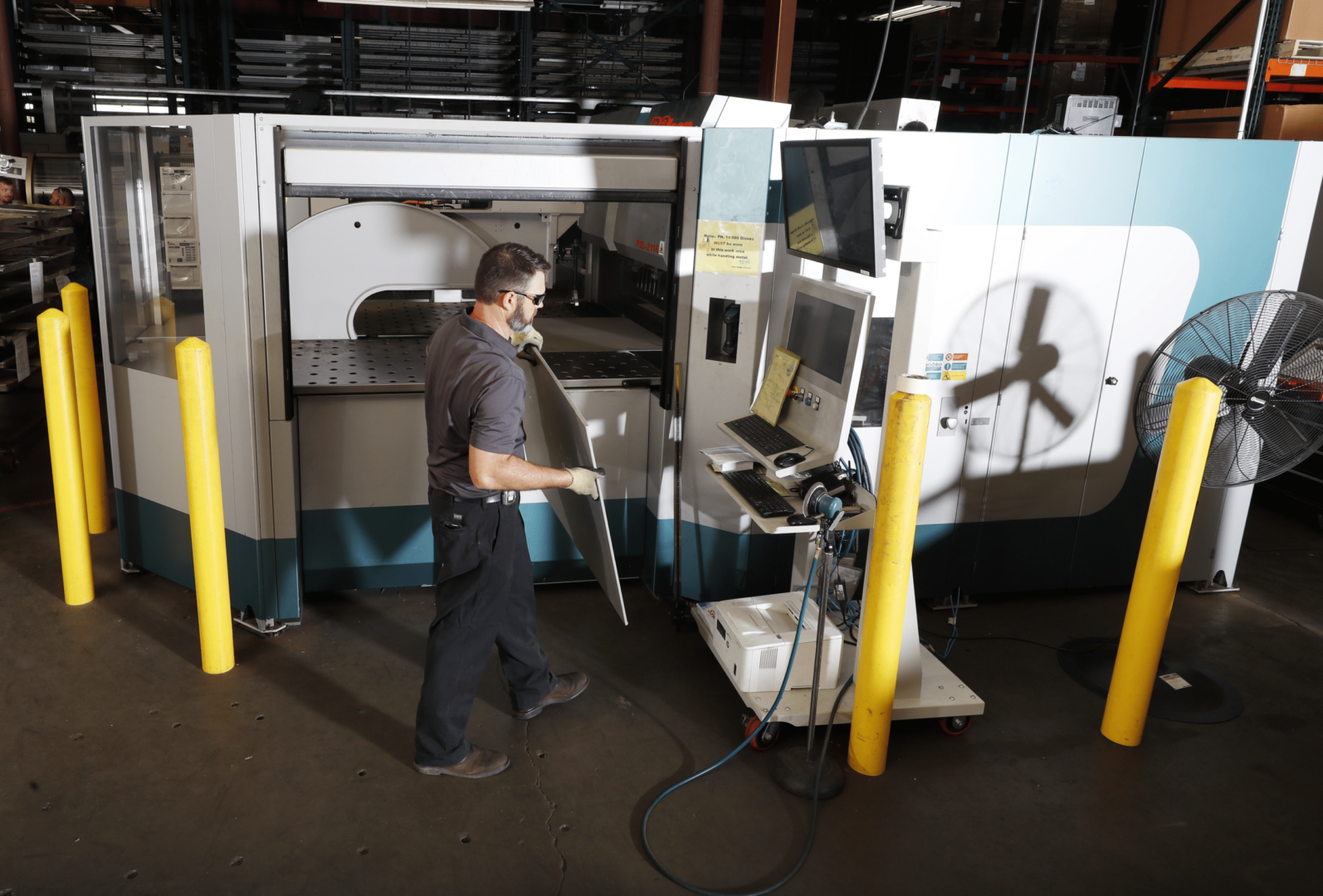
Chad, a panel bender operator here at Estes, is utilizing the Mac 2.0 software on our Salvagnini P2lean to verify bend angles on these base plate panels. This software makes it possible for the P2lean to verify angles on every bend for every part, ensuring accuracy and repeatability. Combining productivity and flexibility, the P2lean enables Chad to produce a large variety of parts with precise, high-quality bends.
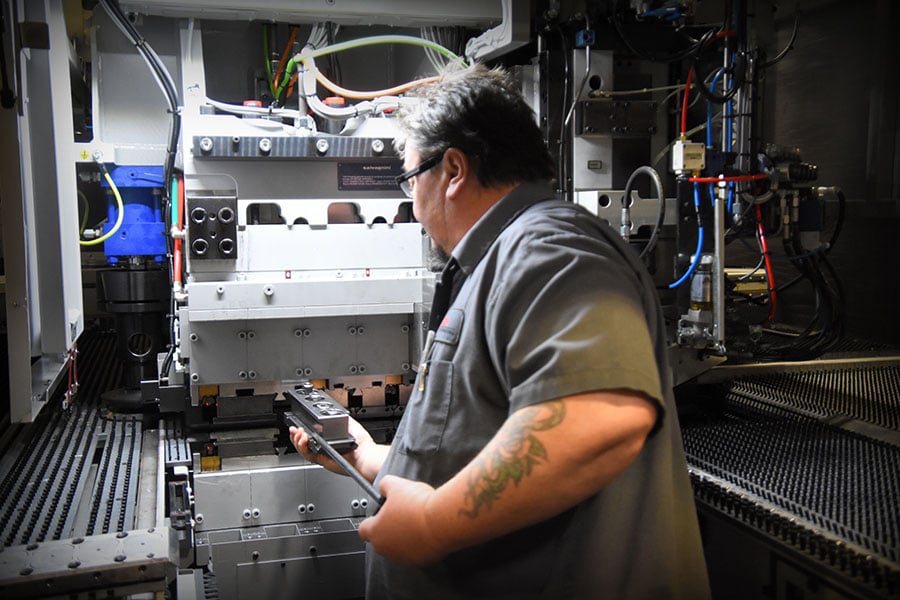
S4 operator, Al, is at our Salvagnini S4Xe punching and shearing system setting up tooling cassettes to punch terminal brackets. Our Salvagnini MV Warehouse brings raw material to the shearing/punching center when directed, and sheets are loaded unattended. The S4 will punch the programmed features into the bracket and then shear the perimeter of the part blank to separate it from the rest of the sheet. The punched parts are then automatically unloaded onto a tray. This automation allows Al to keep our second S4 machine running at the same time. Our S4 punching and shearing system provides extreme accuracy and repeatability to produce high-quality parts and delivers high productivity and process efficiency to ensure on-time delivery for our customers.
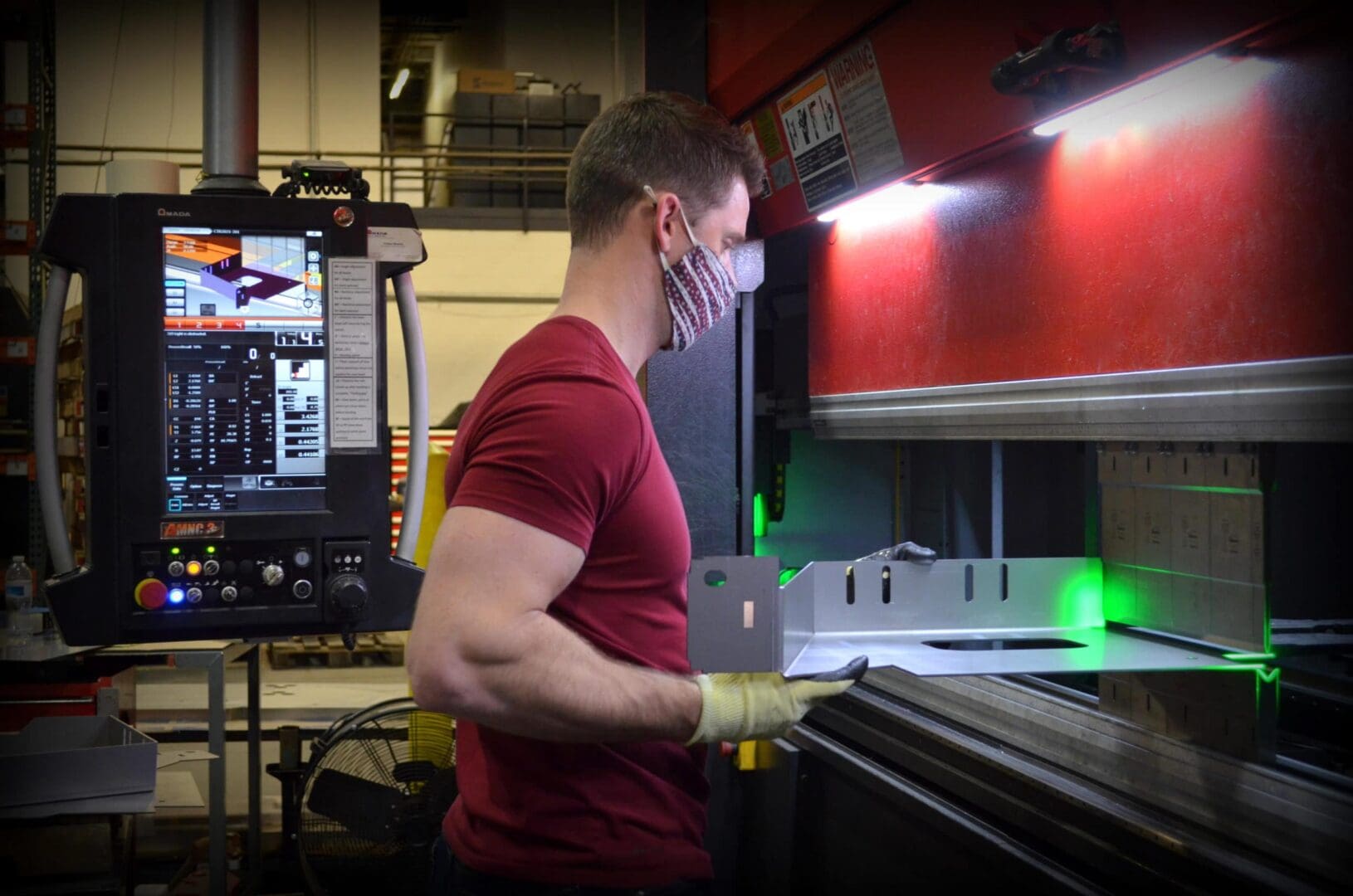
Production manager, John, is at our Amada HG 1003 ATC press brake forming locker mounting brackets. The Automatic Tool Changer (ATC) on the Amada HG allows him to quickly call up part programs and tools through the machine’s AMNC 3i touchscreen control, eliminating the need for any manual setup time. It took less than one minute for the ATC to load the tools required and has the added benefit of displaying high-quality, step-by-step graphics that show the exact bend sequence for every part number run at the machine. The HG also features an integrated bend sensor that automatically detects and corrects for material springback. John utilizes these features on the machine during forming operations to fabricate high-quality parts and reduce lead-times for our customers.
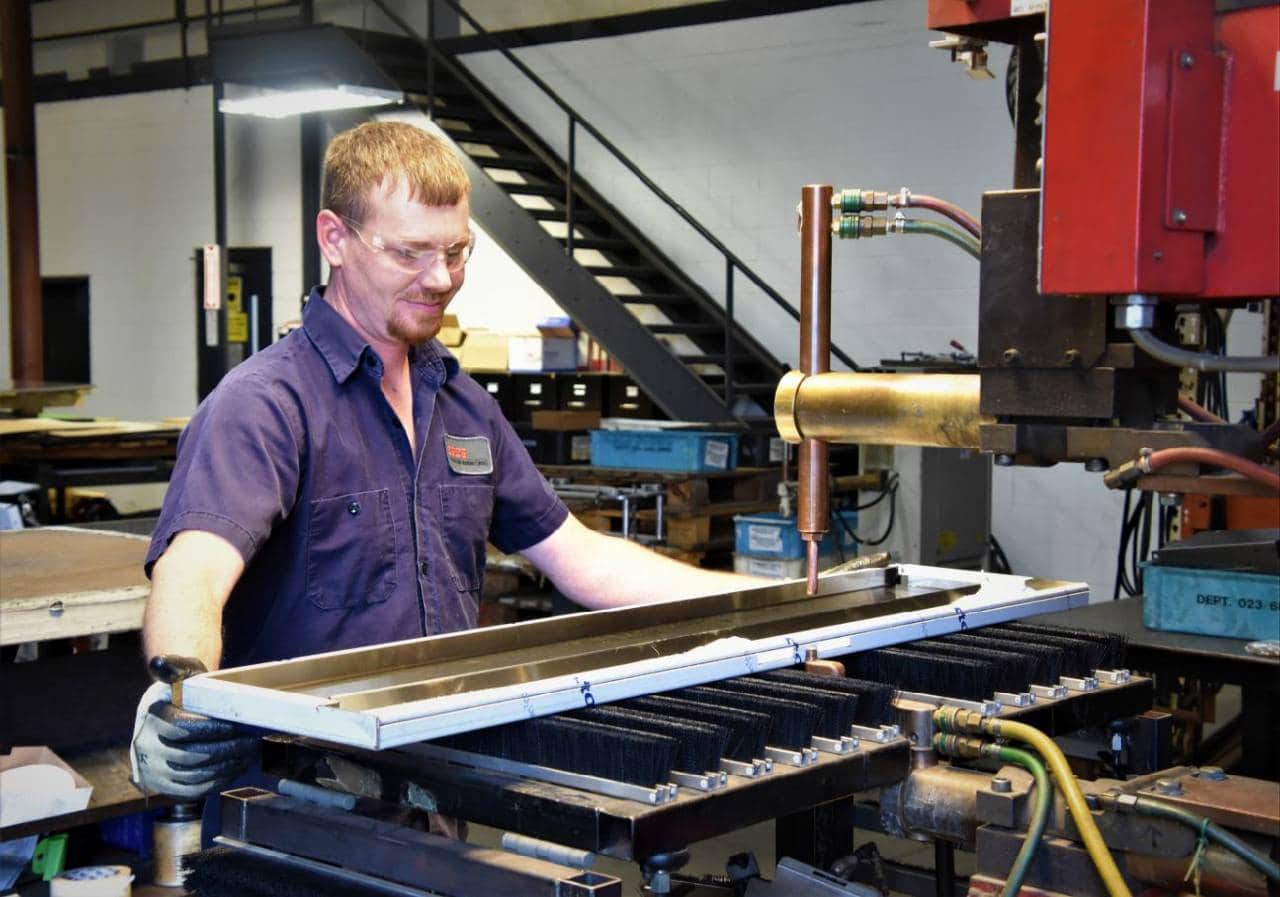
The advanced capabilities of our Salvagnini P2lean allow us to form reinforced flanges into panels like this one instead of fabricating multiple parts for a single assembly. Aaron is at our Amada Spot Welder adding spot welds to this cabinet bottom panel, ensuring the reinforced flange will properly support the rest of the cabinet assembly.
Photo by Emily Roark
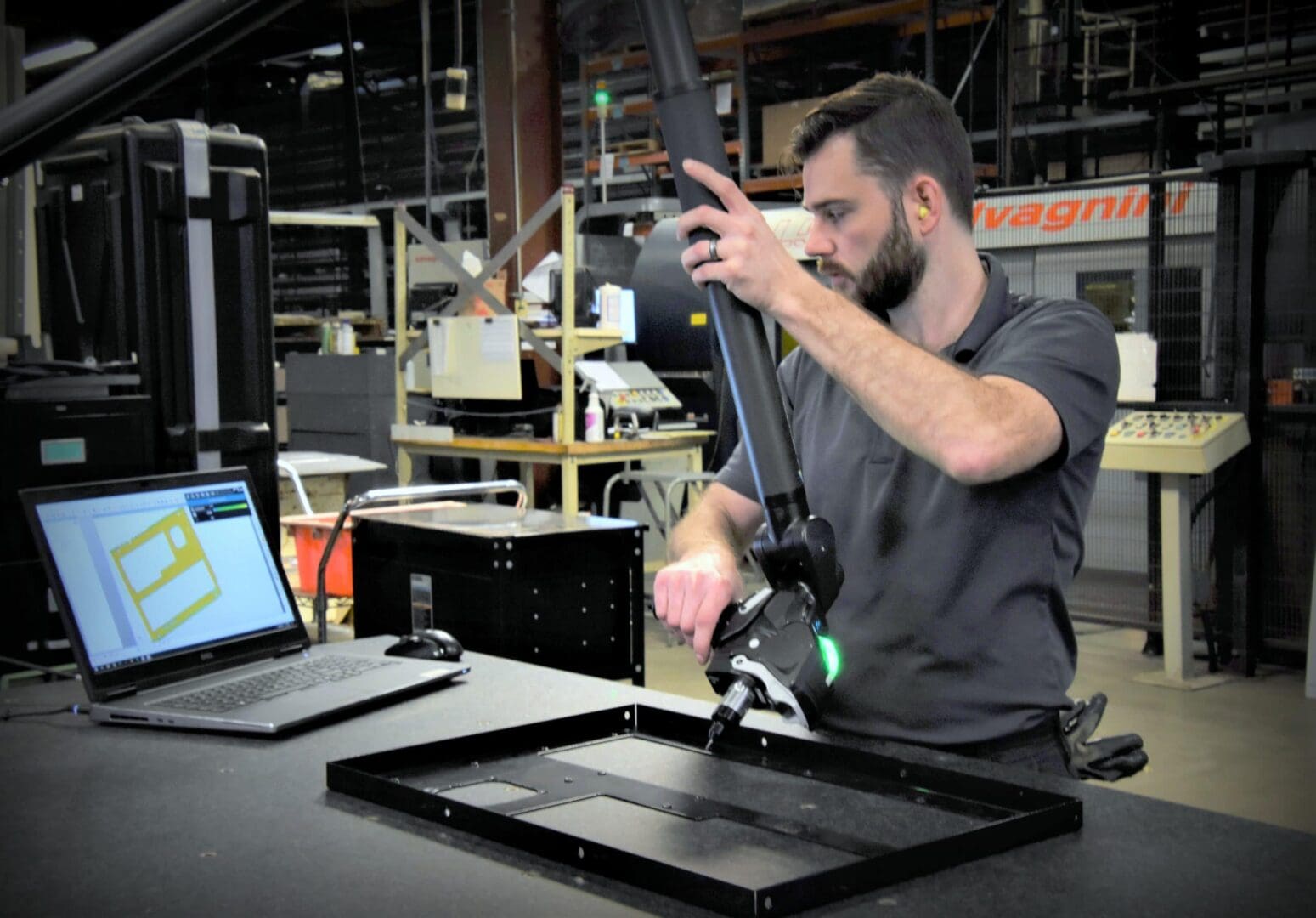
As Quality and Inspection Supervisor on the shop floor, Erik is responsible for ensuring that all fabricated parts manufactured by Estes are within customer specified tolerances and meet all the necessary specifications. Erik is using the Hexagon RS6 Laser Scanner and Romer Absolute Arm to inspect this enclosure cover. The scanner allows him to quickly and efficiently compare the entire manufactured part directly back to the 3D CAD model ensuring that all features and formed edges are within general operating tolerances.
Photo by Emily Roark
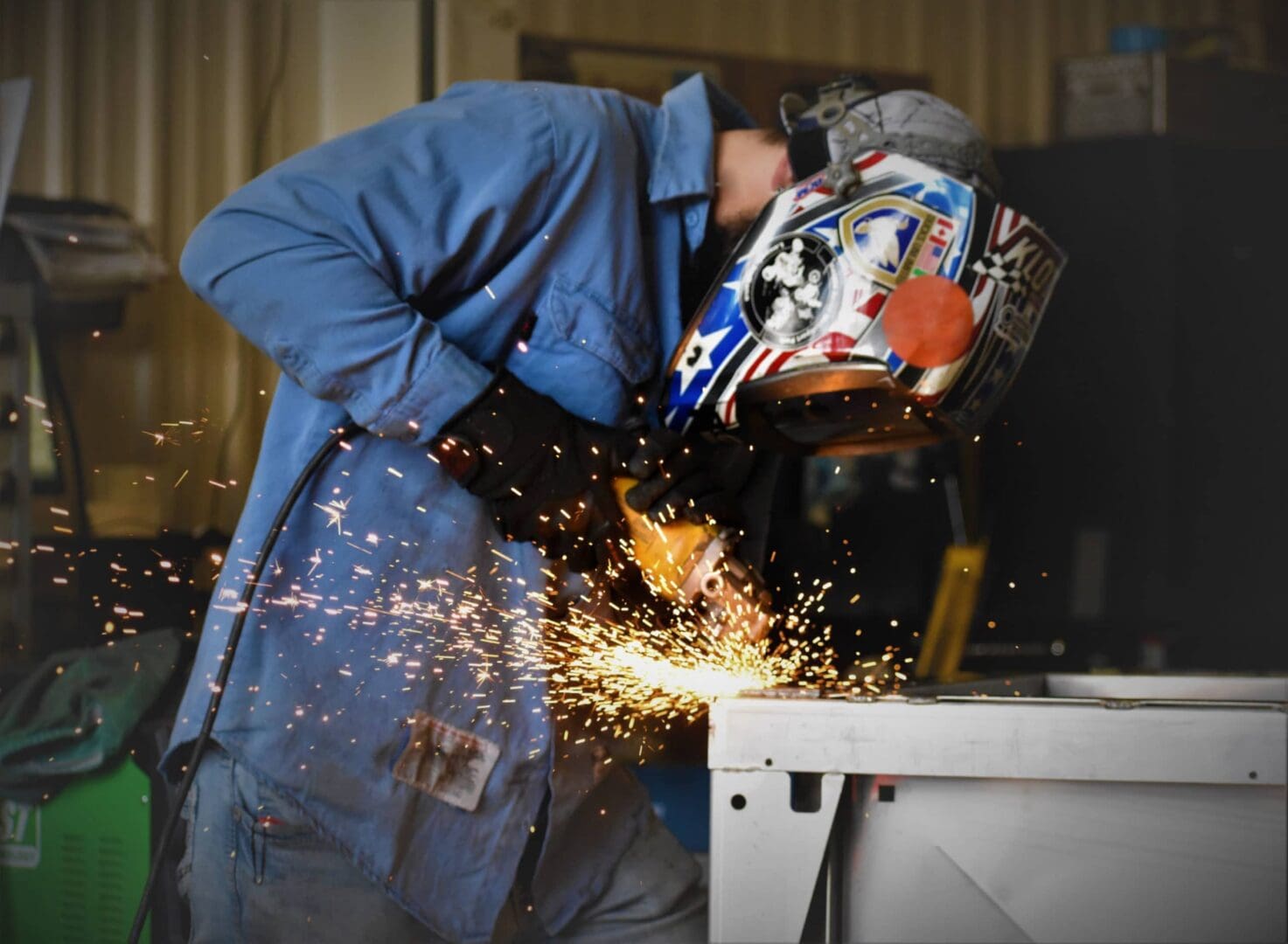
Welder, Reed is in the process of performing post-weld cleanup on TIG welds for this commercial assembly. He is utilizing a wire wheel to blend the heat tinting on the stainless steel material. Once complete, the joining welds will perfectly match the composition of the rest of the part.
Photo by Emily Roark



